#the historical and cultural references in this movie i
Text
ok LISTEN I have SO MUCH respect for animators who work on huge movies but Come On guys with the millions involved you can’t tell me you didn’t look up ONCE how a rider holds their reins??????
#It’s killing me oh my god#Rewatching Frozen and I’m screaming at the screen#I don’t understand how it’s possible that people would spend so much time and money and effort#On researching a culture and looking up references#And then get something like this wrong THIS often????#Unless Northern cultures hold them a different way and then I’m sorry for my inculture#But I doubt it????#Anyway#sorry for the rant#Equestrians watching movies are awful I know#I mostly rant only about this#And the frequency of neighs which is completely unrealistic (plus it’s like the three (3) same neighs in every movie)#And historical inaccuracies about stirrups#And the overuse of friesians even though they are SO fragile they would make terrible war horses#Yeah imma shut up now#Equestrian#ine’s speech bubbles
5 notes
·
View notes
Text
finally finished all of the original star trek... i enjoyed it way more than i ever thought i would
#can't even say that i ship kirk and spock because its not even a question of shipping; it just exists#gained a lot of cultural references and contexts for sci-fi in general too#lol treating the show as like a historical document in a way i guess#i will watch the movies eventually but for now i need to catch up on some reading
2 notes
·
View notes
Text
I'm gonna go out on a limb here and say it's actually a bit disingenuous to say that america, as it exists today, is not in any way a christian nation. it's true that it is not legally a christian nation, that its political bodies were not intended to be theocratic and that the concept of religious freedom and separation of church and state are intrinsic to the constitution. it should never have an official religion, least of all christianity.
but I mean. let's be honest with ourselves. there is no religion more thoroughly baked into american culture than christianity. it's everywhere, and has been everywhere since the colonial period. you see it in our music, you see it in our literature and films, it's in our holidays and customs and cultural practices. and it is in politics, whether we like it or not (and trust me, I do not.)
this is what people mean when they talk about cultural christianity in the us. there's no way around it- even if you yourself are not christian and/or have never been christian, you're surrounded by it. you're going to encounter it, you're going to see it, you might even be influenced by it. if nothing else, you will have to contend with it and you will have to contend with its influence on broader american culture. you just will.
I don't think it helps discourse to deny reality. separation of church and state is essential to maintain and religious freedom must be preserved and protected, religion should have no place in government as the founders intended, and...america is predominantly a culturally christian nation.
#...this post was inspired by of all things an instagram reel parodying battle hymn of the republic#but that particular song is a perfect microcosm of my point here#the song was written in the context of the american civil war#it's a patriotic song#written by an abolitionist#it's about a very specific historical and cultural time period and yet it has survived in the american cultural lexicon to this day#the song is referenced in the title of grapes of wrath which is a seminal piece of american literature#you've seen and heard it parodied and referenced a thousand times#it's played at inaugurations and important political events and sometimes sports games#it's used in movies and tv#I promise you that you know battle hymn of the republic if you grew up here#and what is the most famous lyric that isn't the refrain?#“as he died to make men holy let us die to make men free”#it's a fucking reference to jesus#I mean the whole song is religious#that is the definition of cultural christianity
1 note
·
View note
Text
So I accidentally almost got into an argument on Twitter, and now I'm thinking about bad historical costuming tropes. Specifically, Action Hero Leather Pants.
See, I was light-heartedly pointing out the inaccuracies of the costumes in Black Sails, and someone came out of the woodwork to defend the show. The misunderstanding was that they thought I was dismissing the show just for its costumes, which I wasn't - I was simply pointing out that it can't entirely care about material history (meaning specifically physical objects/culture) if it treats its clothes like that.
But this person was slightly offended on behalf of their show - especially, quote, "And from a fan of OFMD, no less!" Which got me thinking - it's true! I can abide a lot more historical costuming inaccuracy from Our Flag than I can Black Sails or Vikings. And I don't think it's just because one has my blorbos in it. But really, when it comes down to it...
What is the difference between this and this?
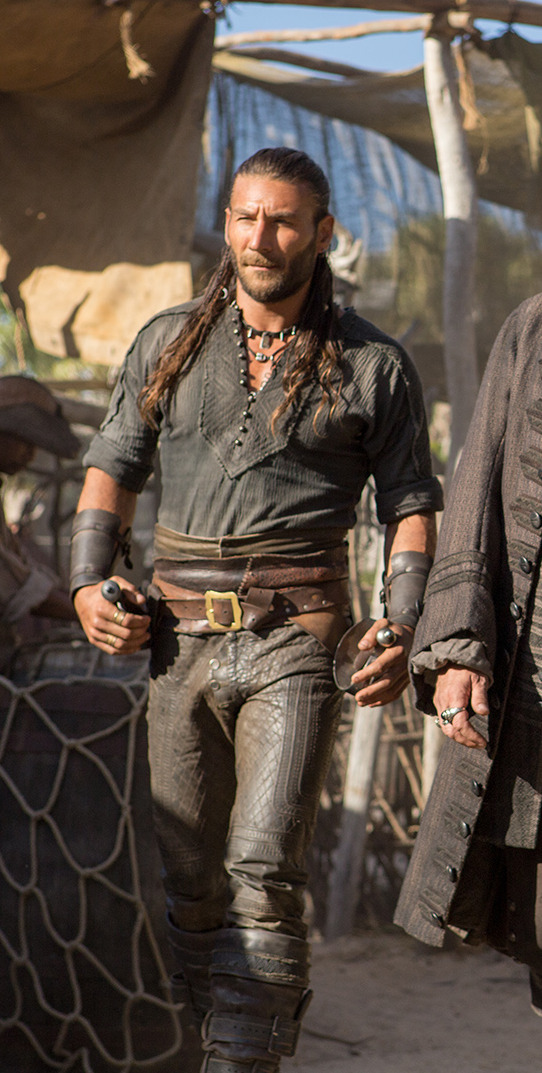
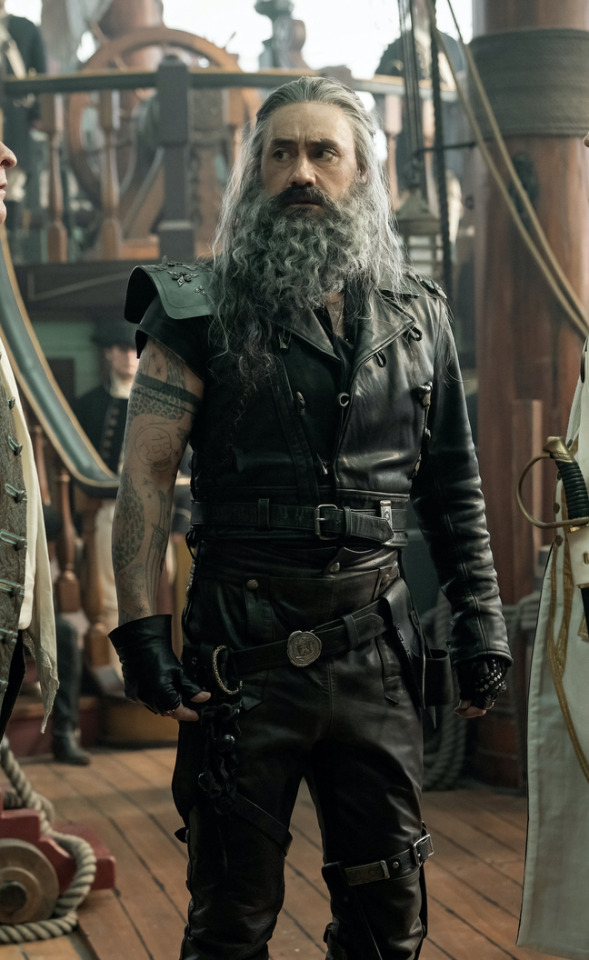
Here's the thing. Leather pants in period dramas isn't new. You've got your Vikings, Tudors, Outlander, Pirates of the Caribbean, Once Upon a Time, Will, The Musketeers, even Shakespeare in Love - they love to shove people in leather and call it a day. But where does this come from?

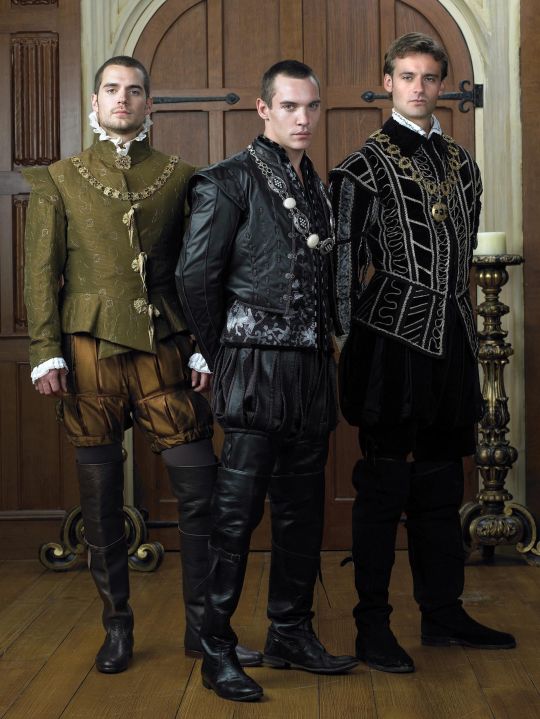
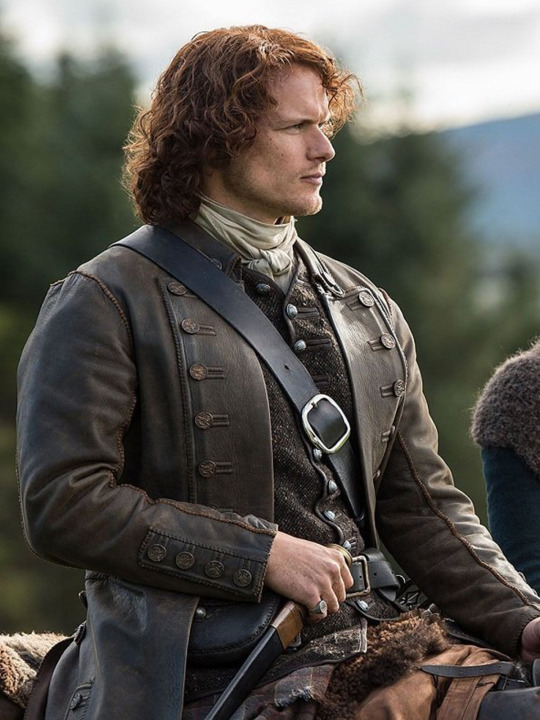

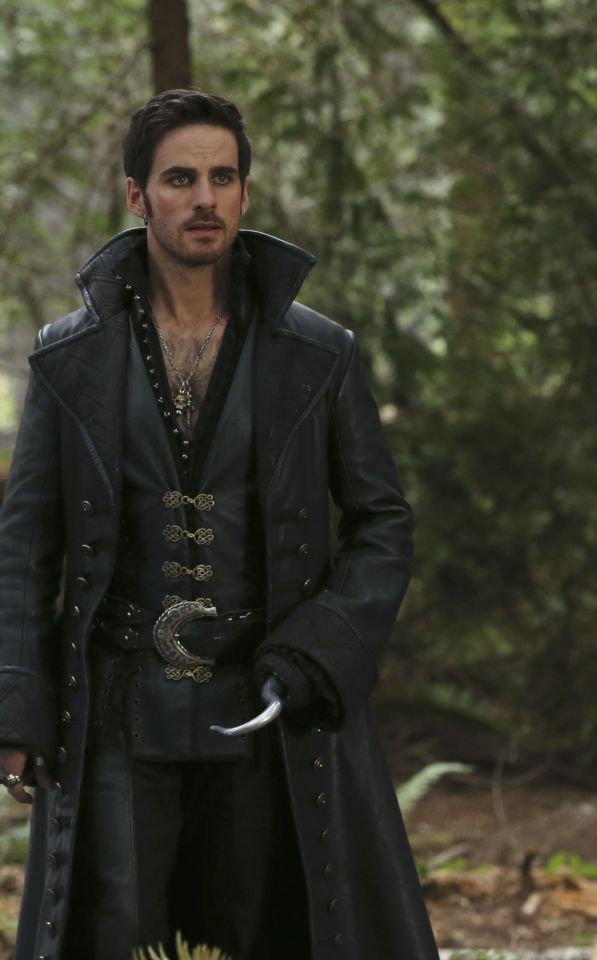
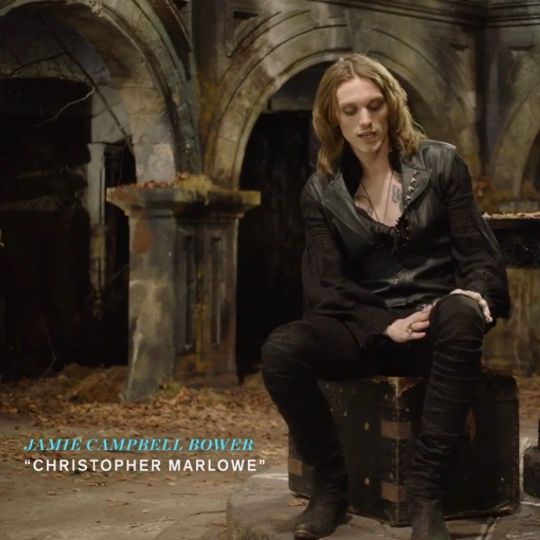
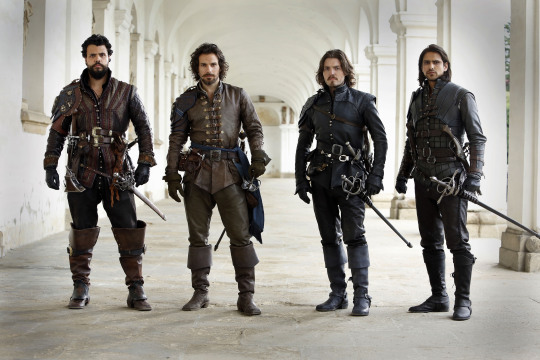

Obviously we have the modern connotations. Modern leather clothes developed in a few subcultures: cowboys drew on Native American clothing. (Allegedly. This is a little beyond my purview, I haven't seen any solid evidence, and it sounds like the kind of fact that people repeat a lot but is based on an assumption. I wouldn't know, though.) Leather was used in some WWI and II uniforms.
But the big boom came in the mid-C20th in motorcycle, punk/goth, and gay subcultures, all intertwined with each other and the above. Motorcyclists wear leather as practical protective gear, and it gets picked up by rock and punk artists as a symbol of counterculture, and transferred to movie designs. It gets wrapped up in gay and kink communities, with even more countercultural and taboo meanings. By the late C20th, leather has entered mainstream fashion, but it still carries those references to goths, punks, BDSM, and motorbike gangs, to James Dean, Marlon Brando, and Mick Jagger. This is whence we get our Spikes and Dave Listers in 1980s/90s media, bad boys and working-class punks.


And some of the above "historical" design choices clearly build on these meanings. William Shakespeare is dressed in a black leather doublet to evoke the swaggering bad boy artist heartthrob, probably down on his luck. So is Kit Marlowe.
But the associations get a little fuzzier after that. Hook, with his eyeliner and jewellery, sure. King Henry, yeah, I see it. It's hideously ahistorical, but sure. But what about Jamie and Will and Ragnar, in their browns and shabby, battle-ready chic? Well, here we get the other strain of Bad Period Drama Leather.
See, designers like to point to history, but it's just not true. Leather armour, especially in the western/European world, is very, very rare, and not just because it decays faster than metal. (Yes, even in ancient Greece/Rome, despite many articles claiming that as the start of the leather armour trend!) It simply wasn't used a lot, because it's frankly useless at defending the body compared to metal. Leather was used as a backing for some splint armour pieces, and for belts, sheathes, and buckles, but it simply wasn't worn like the costumes above. It's heavy, uncomfortable, and hard to repair - it's simply not practical for a garment when you have perfectly comfortable, insulating, and widely available linen, wool, and cotton!
As far as I can see, the real influence on leather in period dramas is fantasy. Fantasy media has proliferated the idea of leather armour as the lightweight choice for rangers, elves, and rogues, a natural, quiet, flexible material, less flashy or restrictive than metal. And it is cheaper for a costume department to make, and easier for an actor to wear on set. It's in Dungeons and Dragons and Lord of the Rings, King Arthur, Runescape, and World of Warcraft.

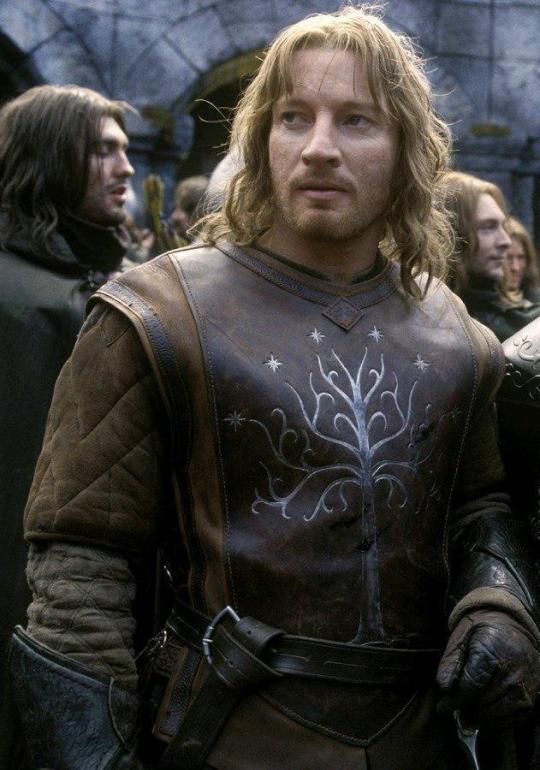
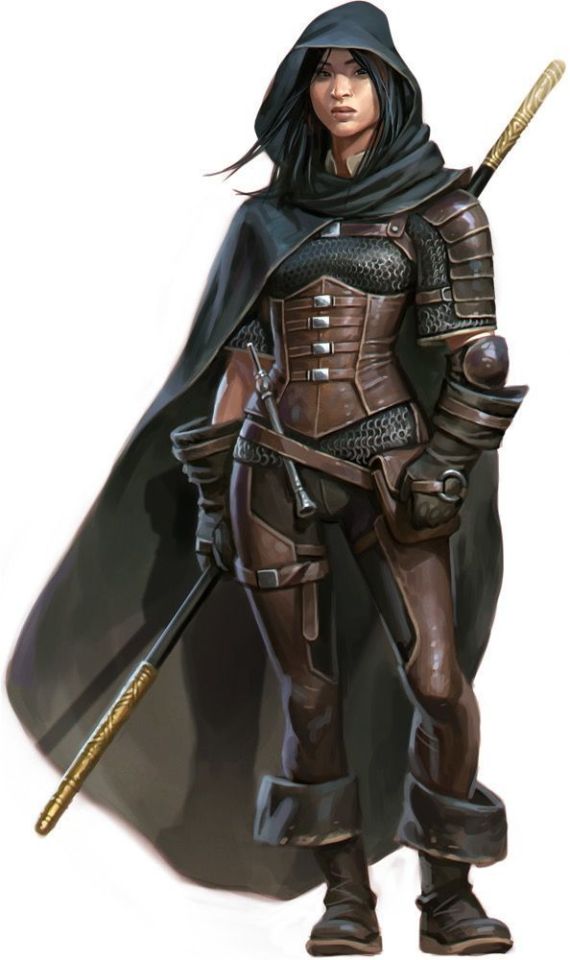
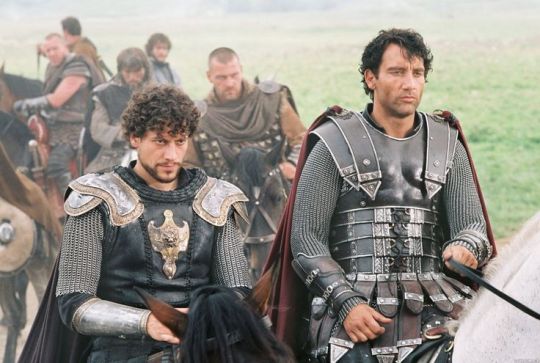

And I think this is how we get to characters like Ragnar and Vane. This idea of leather as practical gear and light armour, it's fantasy, but it has this lineage, behind which sits cowboy chaps and bomber/flight jackets. It's usually brown compared to the punk bad boy's black, less shiny, and more often piecemeal or decorated. In fact, there's a great distinction between the two Period Leather Modes within the same piece of media: Robin Hood (2006)! Compare the brooding, fascist-coded villain Guy of Gisborne with the shabby, bow-wielding, forest-dwelling Robin:

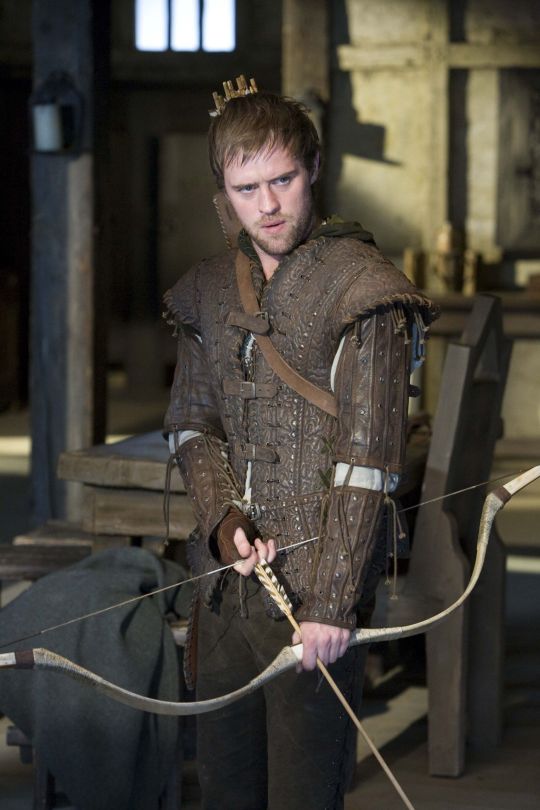
So, back to the original question: What's the difference between Charles Vane in Black Sails, and Edward Teach in Our Flag Means Death?
Simply put, it's intention. There is nothing intentional about Vane's leather in Black Sails. It's not the only leather in the show, and it only says what all shabby period leather says, relying on the same tropes as fantasy armour: he's a bad boy and a fighter in workaday leather, poor, flexible, and practical. None of these connotations are based in reality or history, and they've been done countless times before. It's boring design, neither historically accurate nor particularly creative, but much the same as all the other shabby chic fighters on our screens. He has a broad lineage in Lord of the Rings and Pirates of the Caribbean and such, but that's it.
In Our Flag, however, the lineage is much, much more intentional. Ed is a direct homage to Mad Max, the costuming in which is both practical (Max is an ex-cop and road warrior), and draws on punk and kink designs to evoke a counterculture gone mad to the point of social breakdown, exploiting the thrill of the taboo to frighten and titillate the audience.
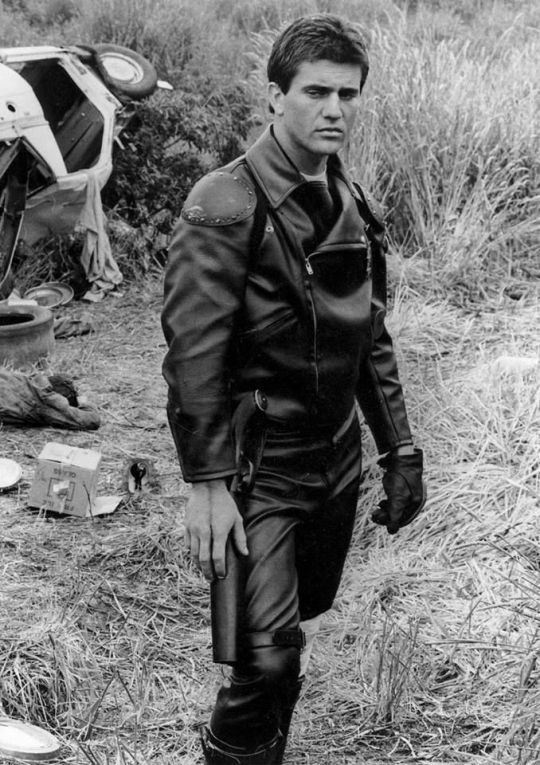
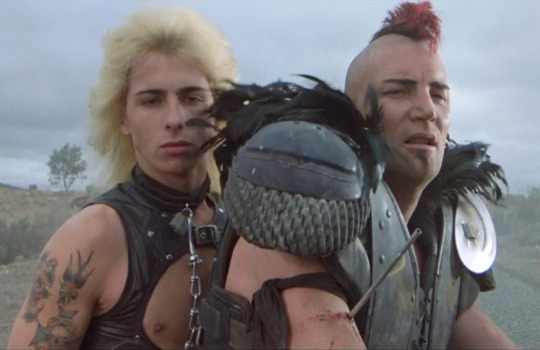
In particular, Ed is styled after Max in the second movie, having lost his family, been badly injured, and watched the world turn into an apocalypse. He's a broken man, withdrawn, violent, and deliberately cutting himself off from others to avoid getting hurt again. The plot of Mad Max 2 is him learning to open up and help others, making himself vulnerable to more loss, but more human in the process.

This ties directly into the themes of Our Flag - it's a deliberate intertext. Ed's emotional journey is also one from isolation and pain to vulnerability, community, and love. Mad Max (intentionally and unintentionally) explores themes of masculinity, violence, and power, while Max has become simplified in the popular imagination as a stoic, badass action hero rather than the more complex character he is, struggling with loss and humanity. Similarly, Our Flag explores masculinity, both textually (Stede is trying to build a less abusive pirate culture) and metatextually (the show champions complex, banal, and tender masculinities, especially when we're used to only seeing pirates in either gritty action movies or childish comedies).
Our Flag also draws on the specific countercultures of motorcycles, rockers, and gay/BDSM culture in its design and themes. Naturally, in such a queer show, one can't help but make the connection between leather pirates and leather daddies, and the design certainly nods at this, with its vests and studs. I always think about this guy, with his flat cap so reminiscient of gay leather fashions.

More overtly, though, Blackbeard and his crew are styled as both violent gangsters and countercultural rockstars. They rove the seas like a bikie gang, free and violent, and are seen as icons, bad boys and celebrities. Other pirates revere Blackbeard and wish they could be on his crew, while civilians are awed by his reputation, desperate for juicy, gory details.
This isn't all of why I like the costuming in Our Flag Means Death (especially season 1). Stede's outfits are by no means accurate, but they're a lot more accurate than most pirate media, and they're bright and colourful, with accurate and delightful silks, lace, velvets, and brocades, and lovely, puffy skirts on his jackets. Many of the Revenge crew wear recognisable sailor's trousers, and practical but bright, varied gear that easily conveys personality and flair. There is a surprising dedication to little details, like changing Ed's trousers to fall-fronts for a historical feel, Izzy's puffy sleeves, the handmade fringe on Lucius's red jacket, or the increasing absurdity of navy uniform cuffs between Nigel and Chauncey.
A really big one is the fact that they don't shy away from historical footwear! In almost every example above, we see the period drama's obsession with putting men in skinny jeans and bucket-top boots, but not only does Stede wear his little red-heeled shoes with stockings, but most of his crew, and the ordinary people of Barbados, wear low boots or pumps, and even rough, masculine characters like Pete wear knee breeches and bright colours. It's inaccurate, but at least it's a new kind of inaccuracy, that builds much more on actual historical fashions, and eschews the shortcuts of other, grittier period dramas in favour of colour and personality.
But also. At least it fucking says something with its leather.
#everyone say 'thank you togas' for not including a long tangent about evil rimmer in red dwarf 5x05#Our Flag Means Death#Togas does meta#and yes these principles DO fall apart slightly in s2 and i DON'T like those costumes as much#don't get me wrong they're fun and gorgeous - but generally a bit less deep and more inaccurate. so. :(#I'm not sure this really says anything new about Our Flag but I just needed to get my thoughts out#i hate hate hate Gritty Period Drama costumes they're so boring and so ugly and so wrong#god bless OFMD for using more than 3 muted colours and actually putting men in heels (and not as a shorthand for rich/foppish villainy) <3#looking at that Tudors still is insane like they really will go to any lengths to not make men feel like they've got bare legs XD#image descriptions in alt text#and yes i DID just sink about two hours into those so you'd better appreciate them
1K notes
·
View notes
Text
I want to talk about Dick Grayson's beauty, sex symbol status, and how it all connects for a moment.
This is a prelude to an upcoming post but I needed to include this separately because the other was getting too big.
First of all Dick Grayson is a beautiful man.
And you're probably thinking "well, no duh. Everyone knows that." but what I mean is Dick Grayson was intentionally made to be beautiful.
For a little historical context, around the late 1950s the culture in the US was changing. It was around this time, that people began exploring and accepting what they called a "feminine man".
This was really taking place in cinema and stuff where they began to show softer versions of men doing "typically female roles" as heroes.
One example is the movie "The Man Who Shot Liberty Valance", a 1962 Hollywood film. In summary, it takes place in the midwest and is centered about Cowboys, gunslingers, the shebang. But the point is, there are two male leads in the movie - Ranse Stoddard (played by Jimmy Stewart) and Tom Donophon (played by John Wayne). Ranse and Tom are both the heroes in the film but with a key difference. Tom is like the sheriff of the town, loved by all and focusing his time on practicing his gun skills. The savior of women and normal people, he's the typical masculine hero. His face is rough and handsome. Ranse however was the new wave. He doesn't care about carrying the gun, he thinks it's uncouth and focuses much of his attention on sending the evil guy (Liberty Valance) to jail through laws. He doesn't want to kill and he takes a more advocative approach. He is also loved by everyone despite not being super masculine. Ranse's face is clean and almost dainty in comparison to Tom and Liberty Valance's.
Despite the complete opposites they are, both men are considered heroes. On one hand, you have the very male typical hero but on the other hand, you have the feminine male hero. At one point the evil guy laughs when Ranse walks in wearing an apron because serving tables is a "woman's job", but Ranse doesn't let it bother him.
How does this connect to Dick Grayson?
Dick Grayson is the feminine hero of DC. DC jumped on the pretty boy hero train.


That's also why in the Teen Titans (1966) comics, Dick keeps being referred to by endearingly feminine pet names by the titans which they seem to only use on him.

Standard gender roles: Men were expected to be strong, aggressive, and bold while women were expected to be polite, accommodating, and nurturing. Sound familiar about a certain duo?
But Dick? He plays both male and female gender roles in a time period where it wasn't socially acceptable to do so.
So my point is, Dick was created to blur the lines between gender and the way his character has progressed - he's meant to be the definition of a man opposite to male toxicity.
He can cook and do laundry whereas Bruce, the image of male dominance cannot.

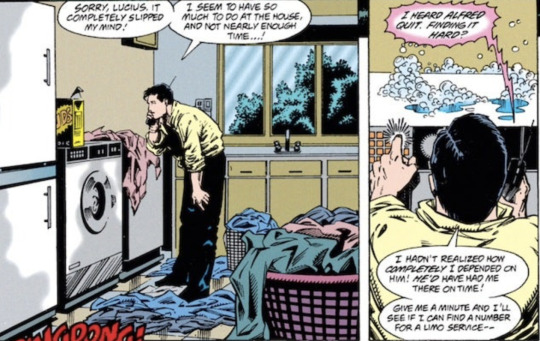
This also falls into another role of Bruce and Dick's but it applies here as well in hindsight.
One thing people need to understand is that Dick was created to be the antithesis of Bruce Wayne. For all the gloominess that Bruce is Dick was meant to be the joy. He is the light to Bruce's darkness.
Which is why Dick often acts as the loving mother to the batfamily while Bruce acts as the stern father. Because Dick was created for the female role.
Part of the reason why I love Dick and Kory is because they do this at a time where girlbossing and malewifing wasn't a thing. Kori is consistently the dominant one when it comes to love in their relationship while Dick plays a softer, more "wife like" role. The way Kori is taller than Dick and buffer than him ✨
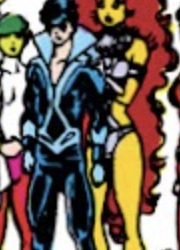
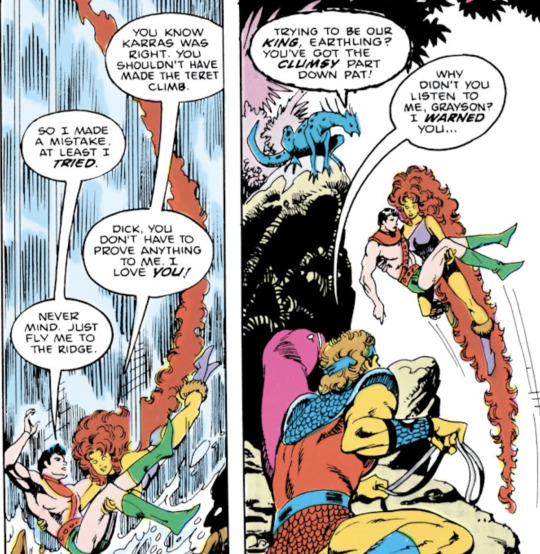
He is quite literally a queen consort - that is the role that Kori begs him to take after she is forced to marry someone her father picks out for her. But Dick refuses in tears because his morality cannot bear becoming a mistress and ruining someone else's marriage.
I know this is a long tangent but here's where the sex symbol comes in. Dick was created to be the most beautiful figure in DC but him being beautiful is not supposed to be confused with him being objectified.
Being beautiful is just something he was born as. What people do as a result has nothing to with DC
Take this for instance
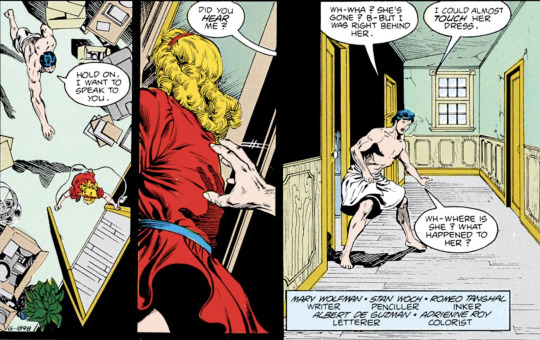
He's literally just showering and comes out of the shower to find a random little girl singing about his and batman's identities. Creepy? Yes. Very much so. So he chases after her and finds her gone. Well there's nothing he can do now, he needs to go back and analyze what's going on and contact the other titans-

Crap.

Look at all the women that are ogling him, and even the ginger looks as if he doesn't know if he's jealous or wants to join - but there's nothing Dick did to make them do that. He's literally minding his own business and got caught outside. Did he hit on the women? Did he seduce them? Did he purposefully show off and make a loud commotion because he wanted the attention? No!
Arguing that Dick Grayson shouldn't be a sex symbol just seems wrong to me considering that it's not a fault of his.
It's like telling Kori not to have large breasts and telling Dinah not to wear fishnets.
People still ogle them regardless of how they dress because they're just that attractive. You can't tell someone to look a different way because you don't like the attention they're receiving...that's literally the opposite of everything people should be fighting for
Arguing that Dick Grayson being a sex symbol is a problem because he's too beautiful and blaming the actions of other characters for thinking so is just...
it's wrong.
He was created to be beautiful to fight male toxic masculinity. He's woman coded for a reason.
We should be embracing him. He represents everything male freedom should be about. He constantly placed in a female role, in female positions-

In queer positions-

He's acrobatic, slender, and sensual. He's gentle, loving, and beautiful.
When has the beauty of a person ever been a reflection of their character? The way fandom is going, it's implying that because female characters make sexualized comments about Dick's body, it's somehow Dick's fault for looking that way. We're blaming him for his "womanizing" ways as if he hasn't put his heart and soul into every relationship he's had. And while we're busy calling him a womanizer, we conveniently forget that the women he's in relationships with have significant personalities of their own. We inadvertently reduce their beings to plastic bags, ignoring that they have broken up with each other because of being unable to resolve conflicting beliefs, different career paths, different lifestyles, and more. It's not a one way road with our treatment of Dick. It's a two way street because we're harming both Dick and strong women like Kori, Barbara, Bea, Shawn, and Helena by pretending what they believe in and live for is unimportant in love.
Instead we should be exploring how the objectification might have an impact on Dick's mental health rather than blaming DC for using characters to describe how hot Dick is.
All the beautiful traits of Dick Grayson - his ambiguous sexuality, his overwhelming love for people, his affection for his friends, the way he cries and feels for others - all of it is beautiful, is it not?
From his very creation Dick was meant to be someone who breaks gender roles. The constant attraction he receives from both men and women in all of DC's media is evidence of that. The Grayson comics push the boundaries of his sexuality as much as DC will allow. To be queer without coming out with it. He is the feminine hero.
Everyone seems to hate that he's being called a sex symbol but why does that bother you? Dick Grayson IS the pretty girl of the comic universe. He IS the babygirl of DC.
DC has created the perfect view of what it's like to be a woman through Dick Grayson and we're spitting on the most accurate representation of a female that comics have ever created by blaming them for expressing what it's like to live as a woman.
#dick grayson#nightwing#I would love to hear people's thoughts on this bc I genuinely don't get the problem with him being portrayed as hot#bruce wayne#batman#dickkori#my thoughts on the sex symbol thing#prelude to my next post#koriand'r
2K notes
·
View notes
Text
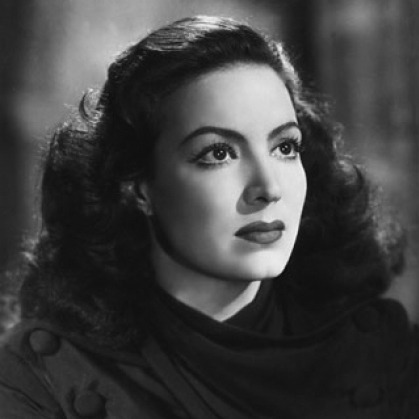
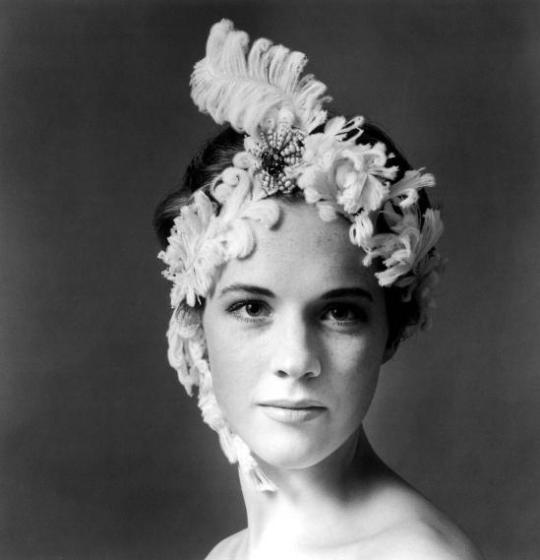
Propaganda
María Félix (Doña Barbara, La Mujer sin Alma, Rio Escondido, La Cucaracha)—Maria Felix is still possibly the most well-known Mexican film actress. She turned down multiple-roles in Hollywood and a contract with Metro-Goldwyn-Meyer in order to take roles in Mexico, France, and Argentine throughout the 1940s, 50s, 60s. She was so famous and so respected as a dramatic actress that she inspired painters, novelists and poets in their own art--she was painted by Diego Rivera, Jose Orozco, Bridget Tichenor. The novelist Carlos Fuentes used her as inspiration for his protagonist in Zona Sagrada. She inspired an entire collection by Hermes. In the late 1960s Cartier made her a custom collection of reptile themed jewels. She considered herself to be powerful challenger of morality and femininity in Mexico & worldwide--she routinely played powerful women in roles with challenging moral choices and free sexuality. But even still, years after he death, she is celebrated with Google Doodles, and appearances in the movie Coco, and holidays for the anniversary of her death.
Julie Andrews (The Sound of Music, Mary Poppins)—Oh where to start .... I'm not sure I even know how. She's just perfection. And it's not fair I can't bring post 70s work into this, because she just gets better and better, and her drag performance in to die for. But in the era I CAN talk about, she shows she has THE RANGE. Beautiful, feisty, funny, holding her own against Christopher Plummer, Paul Newman, Rock Hudson. Oh she's luminous.
This is round 4 of the tournament. All other polls in this bracket can be found here. Please reblog with further support of your beloved hot sexy vintage woman.
[additional propaganda submitted under the cut.]
María Félix:
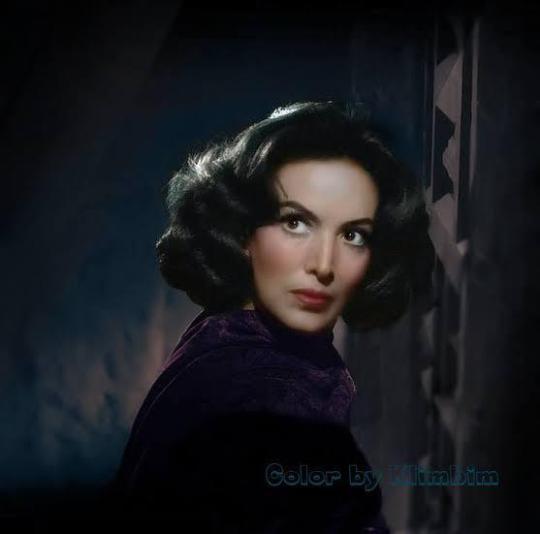
She's Thee Hot Vintage Movie Woman of México. She's absolutely gorgeous and always looks like she's about to step on you. you WILL be thankful if she does.

"María Félix is a woman -- such a woman -- with the audacity to defy the ideas machos have constructed of what a woman should be. She's free like the wind, she disperses the clouds, or illuminates them with the lightning flash of her gaze." - Octavio Paz
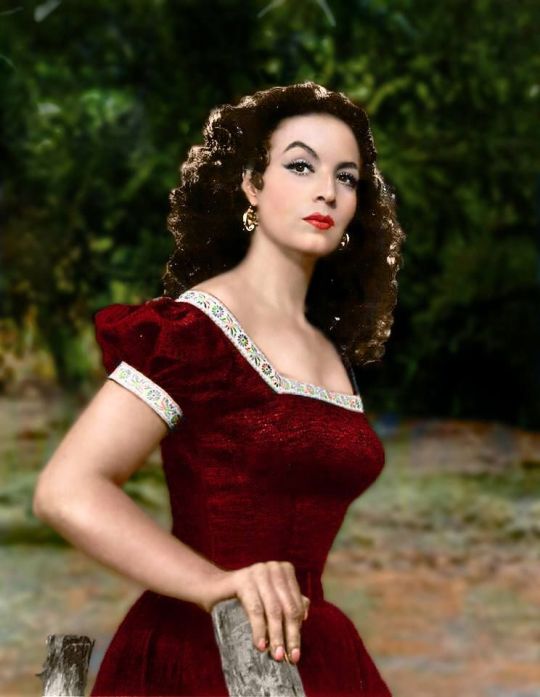

María Félix is one of the most iconic actresses of the Golden Era of Mexican Cinema. La Doña, as she was lovingly nicknamed, only had one son, and when her first marriage ended in divorce her ex-husband stole her only child, so she vowed that one day she’d be more influential than her ex and she’d get her son back. AND SHE DID! María Félix rejected a Hollywood acting role to start her acting career in Mexico on her own terms with El Peñón de las Ánimas (The Rock of Souls) starring alongside actor, and future third husband, Jorge Negrete. She quickly rose to incredible heights both in Mexico and abroad, later on rejecting a Hollywood starring role (Duel in the Sun) as she was already committed to the movie Enamorada at the planned filming time. Of this snubbing she said, quote: “I will never regret saying no to Hollywood, because my career in Europe was focused in [high] quality cinema. [My] india* roles are made in my country, and [my] queen roles are abroad.” (Translator notes: here the “india” role means interpreting a lower-class Mexican woman, usually thought of indigenous/native/mixed descent —which she had interpreted and reinvented throughout her acting career in Mexico— and what abroad was typically considered the Mexican woman stereotype, with the braids, long simple skirts, and sandals. This also references the expectation of her possibly helping Hollywood in perpetuating this stereotype for American audiences that lack the cultural and historical contexts of this type of role which would undermine her own efforts against this type of Mexican stereotypes while working in Europe) She was considered one of the most beautiful women in the world of her time by international magazines like Life, París Match, and Esquire, and was a muse to a vast number of songwriters (including her second husband Agustin Lara,), artists, designers, and writers. Muralist Diego Rivera described her as “a monstrously perfect being. She’s an exemplary being that drives all other human beings to put as much effort as possible to be like her”. Playwriter Jean Cocteau, who worked with her in the Spanish film La Corona Negra (The Black Crown) said the following about her, “María, that woman is so beautiful it hurts”. Haute Couture houses like Dior, Givenchy, Yves Saint Laurent, Balenciaga, Hérmes, among others, designed and dressed her throughout her life. She died on her birthday, April 8, 2002, at 88 years old, in Mexico City. She was celebrated by a parade from her home to the Fine Arts Palace in the the city’s Historic Downtown, where a multitude of people paid tribute to her. Her filmography includes 47 movies from 1942 until 1970, and only two television acting roles in 1970. She has 2 music albums, one recorded with her second husband, Agustín Lara, in 1964 titled La Voz de María y la inspiración de Agustín «The voice of María and the inspiration of Augustín», and her solo album Enamorada «In Love» in 1998. Her bespoke Cartier jewelry is exhibited alongside Elizabeth Taylor’s, Grace Kelly’s and Gloria Swanson’s. In 2018, Film Director Martin Scorsese presented a restored and remastered version of her film Enamorada in the Cannes Classics section of the Cannes Festival and Google dedicated a doodle for her 104th birthday. On august 2023 Barbie added her doll to the Tribute Collection.
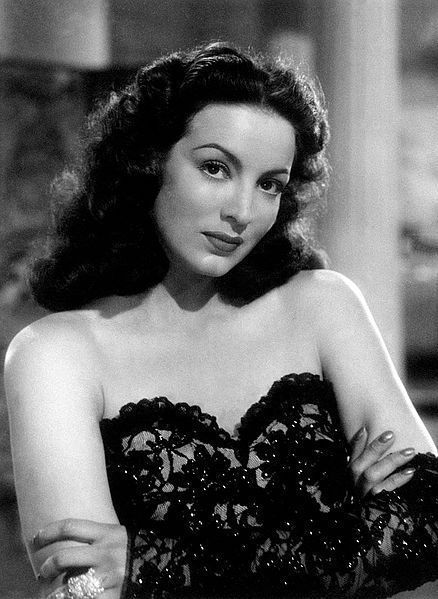
Julie Andrews propaganda:

"She has such a simple but amazing beauty to her. Not to mention her amazing and melodic singing voice!"

"Roles like nannies and governesses can make us forget how attractive she was! A perfect combination of elegant and adorable, with the most incredible vocal range to boot!"
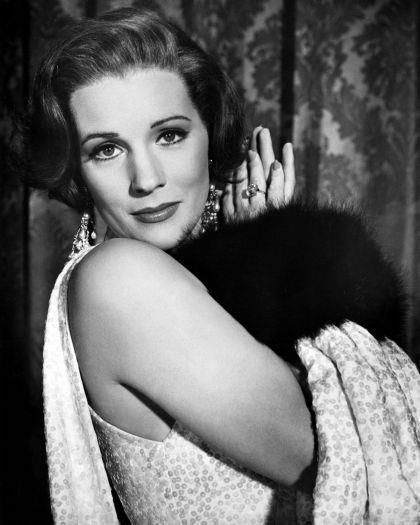
"Besides having one of the most amazing singing voices ever to grace the silver screen, Julie always had an understated beauty to her that wasn't always shown off on screen. But it's there nonetheless because her characters managed to pull some of the hottest men ever to grace the screen."
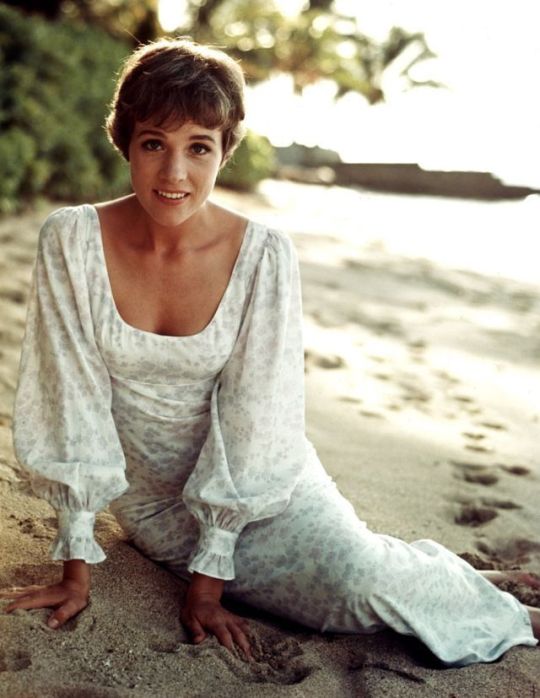
"The juxtaposition between carefree Maria and stern but fun Mary Poppins shows the power of the acting of this HOT VINTAGE MOVIE WOMAN"
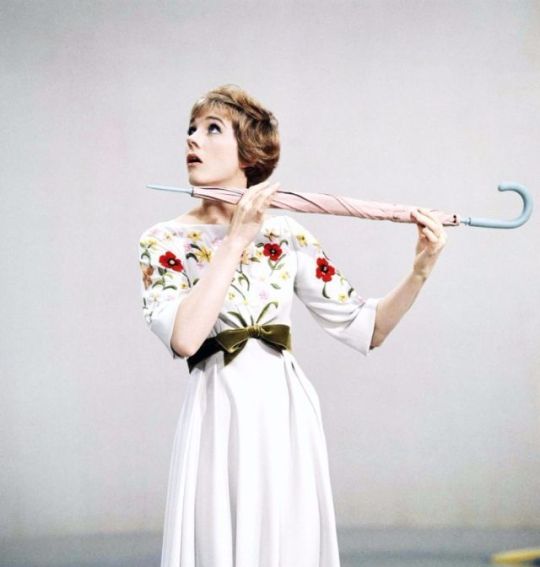
"Charming, genteel, incredibly charismatic, beautiful, and has an angelic singing voice to boot. Her screen roles as Maria in The Sound of Music and Mary Poppins are absolutely iconic for a reason and she originated several well-known Broadway roles before those."

"the most beautiful woman 12 year old me had ever seen possibly"
"OMG OMG OMG she’s definitely been submitted before how could she NOT but!!!! I loveeee her so muchhhh rahhhh prebby!!!! cool!!!! mary poppins the beloved <33333 some people dislike it but I love jolly holiday so much because it IS a jolly holiday with Mary!!! no wonder that it’s Mary that we love!!!!!"
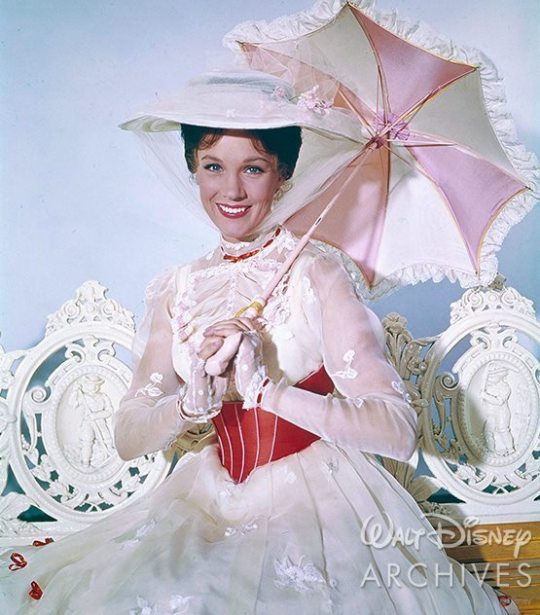
"I know many people who were taught in singing lessons "when in doubt, pronounce words how julie andrews would pronounce them." THATS CALLED INFLUENCE. THATS CALLED MOTHERING THOUSANDS."
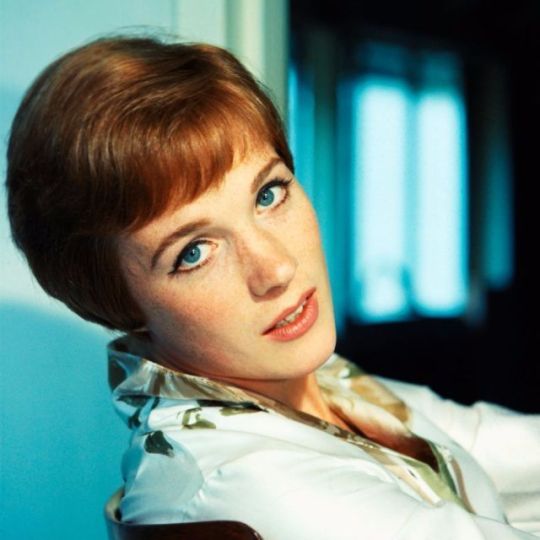
479 notes
·
View notes
Text
Cross-posting an essay I wrote for my Patreon since the post is free and open to the public.

Hello everyone! I hope you're relaxing as best you can this holiday season. I recently went to see Miyazaki's latest Ghibli movie, The Boy and the Heron, and I had some thoughts about it. If you're into art historical allusions and gently cranky opinions, please enjoy. I've attached a downloadable PDF in the Patreon post if you'd prefer to read it that way. Apologies for the formatting of the endnotes! Patreon's text posting does not allow for superscripts, which means all my notations are in awkward parentheses. Please note that this writing contains some mild spoilers for The Boy and the Heron.

Hayao Miyazaki’s 2023 feature animated film The Boy and the Heron reads as an extended meditation on grief and legacy. The Master of a grand tower seeks a descendant to carry on his maddening duty, balancing toy blocks of magical stone upon which the entire fabric of his little pocket of reality rests. The world’s foundations are frail and fleeting, and can pass away into the cold void of space should he neglect to maintain this task. The Master’s desire to pass the torch undergirds much of the film’s narrative.

(Isle of the Dead. Arnold Böcklin. 1880. Oil on Canvas. Kunstmuseum. Basel, Switzerland.)
Arnold Böcklin, a Swiss Symbolist(1) painter, was born on October 16 in 1827, the same year the Swiss Evangelical Reformed Church bought a plot of land in Florence from the Grand Duke of Tuscany, Leopold II, that had long been used for the burials of Protestants around Florence. It is colloquially known as The English Cemetery, so called because it was the resting place of many Anglophones and Protestants around Tuscany, and Böcklin frequented this cemetery—his workshop was adjacent and his infant daughter Maria was buried there. In 1880, he drew inspiration from the cemetery, a lone plot of Protestant land among a sea of Catholic graveyards, and began to paint what would be the first of six images entitled Isle of the Dead. An oil on canvas piece, it depicts a moody little island mausoleum crowned with a gently swaying grove of cypresses, a type of tree common in European cemeteries and some of which are referred to as arborvitae. A figure on a boat, presumably Charon, ferries a soul toward the island and away from the viewer.

(Photo of The English Cemetery in Florence. Samuli Lintula. 2006.)
The Isle of the Dead paintings varied slightly from version to version, with figures and names added and removed to suit the needs of the time or the commissioner. The painting was glowingly referenced and remained fairly popular throughout the late 19th and early 20th centuries. The painting used to be inescapable in much of European popular culture. Professor Okulicz-Kozaryn, a philologist (someone with a deep interest in the ways language and cultural canons evolve)(2) observed that the painting, like many other works in its time, was itself iterative and became widely reiterated and referenced among its contemporaries. It became something like Romantic kitsch in the eyes of modern art critics, overwrought and excessively Byronic. I imagine Miyazaki might also resent a work of that level of manufactured ubiquity, as Miyazaki famously held Disney animated films in contempt (3). Miyazaki’s films are popularly aspirational to young animators and cartoonists, but gestures at imitation typically fall well short, often reducing Miyazaki’s weighty films to kitschy images of saccharine vibes and a lazy indulgence in a sort of empty magical domestic coziness. Being trapped in a realm of rote sentiment by an uncritical, unthoughtful viewership is its own Isle of Death.

(Still from The Boy and the Heron, 2023. Studio Ghibli.)
The Boy and the Heron follows a familiar narrative arc to many of Miyazaki’s other films: a child must journey through a magical and quietly menacing world in order to rescue their loved ones. This arc is an echo of Satsuki’s journey to find Mei in My Neighbor Totoro (1988) and Chihiro’s journey to rescue her parents Spirited Away (2001). To better understand Miyazaki’s fixation with this particular character journey, it can be instructive to watch Lev Atamanov’s 1957 animated film, The Snow Queen (4)(5), a beautifully realized take on Hans Christian Andersen’s 1844 children’s story (6)(7). Mahito’s journey continues in this tradition, as the boy travels into a painted world to rescue his new stepmother from a mysterious tower.
Throughout the film, Miyazaki visually references Isle of the Dead. Transported to a surreal world, Mahito initially awakens on a little green island with a gated mausoleum crowned with cypress trees. He is accosted by hungry pelicans before being rescued by a fisherwoman named Kiriko. After a day of catching and gutting fish, Mahito wakes up under the fisherwoman’s dining table, surrounded by kokeshi—little wooden dolls—in the shapes of the old women who run Mahito’s family’s rural household. Mahito is told they must not be touched, as the kokeshi are wards set up for his protection. There is a popular urban legend associated with the kokeshi wherein they act as stand-ins for victims of infanticide, though there seems to be very little available writing to support this legend. Still, it’s a neat little trick that Miyazaki pulls, placing a stray reference to a local legend of unverifiable provenance that persists in the popular imagination, like the effect of fairy stories passed on through oral retellings, continually remolded each new iteration.
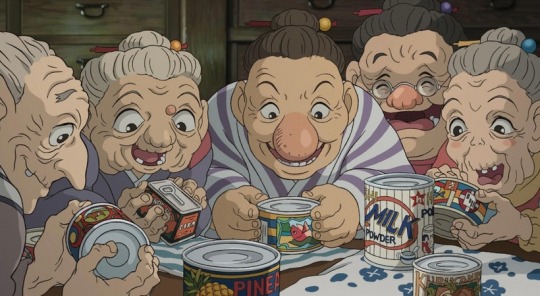
(Still from The Boy and the Heron, 2023. Studio Ghibli.)
Kiriko’s job in this strange landscape is to catch fish to nourish unborn spirits, the adorable floating warawara, before they can attempt to ascend on a journey into the world of the living. Their journey is thwarted by flocks of supernatural pelicans, who swarm the warawara and devour them. This seems to nod to the association of pelicans with death in mythologies around the world, especially in relationship to children (8). Miyazaki’s pelicans contemplate the passing of their generations as each successive generation seems to regress, their capacity to fulfill their roles steadily diminishing.
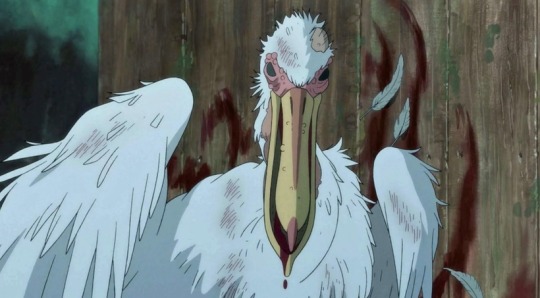
(Still from The Boy and the Heron, 2023. Studio Ghibli.)
As Mahito’s adventure continues, we find the landscapes changing away from Böcklin’s Isle of the Dead into more familiar Ghibli territories as we start to see spaces inspired by one of Studio Ghibli’s aesthetic mainstays, Naohisa Inoue and his explorations of the fantasy realms of Iblard. He might be most familiar to Ghibli enthusiasts as the background artists for the more fantastical elements of Whisper of the Heart (1995).

(Naohisa Inoue, for Iblard Jikan, 2007. Studio Ghibli.)
By the time we arrive at the climax of The Boy and the Heron, the fantasy island environment starts to resemble English takes on Italian gardens, the likes of which captivated illustrators and commercial artists of the early 20th century such as Maxfield Parrish. This appears to be a return to one of Böcklin’s later paintings, The Island of Life (1888), a somewhat tongue-in-cheek reaction to the overwhelming presence of Isle of the Dead in his life and career. The Island of Life depicts a little spot of land amid an ocean very like the one on which Isle of the Dead’s somber mausoleum is depicted, except this time the figures are lively and engaged with each other, the vegetation lush and colorful, replete with pink flowers and palm fronds.

(Island of Life. Arnold Böcklin. Oil on canvas. 1888. Kunstmuseum. Basel, Switzerland.)
In 2022, Russia’s State Hermitage Museum in Saint Petersburg acquired the sixth and final Isle of the Dead painting. In the last year of his life, Arnold Böcklin would paint this image in collaboration with his son Carlo Böcklin, himself an artist and an architect. Arnold Böcklin spent three years painting the same image three times over at the site of his infant daughter’s grave, trapped on the Isle of the Dead. By the time of his death in 1901 at age 74, Böcklin would be survived by only five of his fourteen children. That the final Isle of the Dead painting would be a collaboration between father and son seemed a little ironic considering Hayao Miyazaki’s reticence in passing on his own legacy. Like the old Master in The Boy and the Heron, Miyazaki finds himself with no true successors.
The Master of the Tower's beautiful islands of painted glass fade into nothing as Mahito, his only worthy descendant, departs to live his own life, fulfilling the thesis of Genzaburo Yoshino’s 1937 book How Do You Live?, published three years after Carlo Böcklin’s death. In evoking Yoshino and Böcklin’s works, Hayao Miyazaki’s The Boy and the Heron suggests that, like his character the Master, Miyazaki himself must make peace with the notion that he has no heirs to his legacy, and that those whom he wished to follow in his footsteps might be best served by finding their own paths.
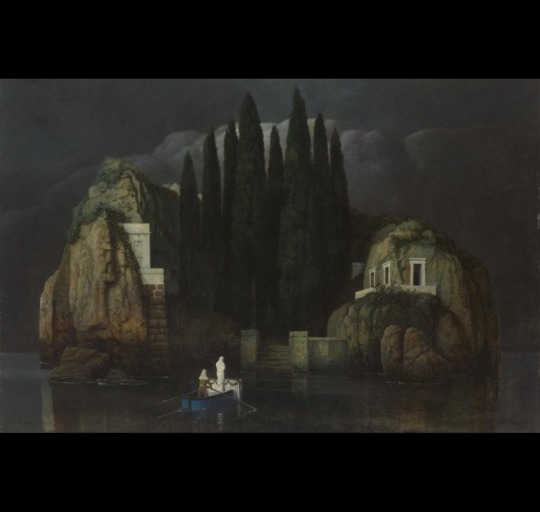
(Isle of the Dead. Arnold and Carlo Böcklin. Oil on canvas. 1901. The State Hermitage Museum. Saint Petersburg, Russia.)
INFORMAL ENDNOTES
1 - Symbolists are sort of tough to nail down. They were started as a literary movement to 1 distinguish themselves from the Decadents, but their manifesto was so vague that critics and academics fight about it to this day. The long and the short of it is that the Symbolists made generous use of a lot of metaphorical imagery in their work. They borrow a lot of icons from antiquity, echo the moody aesthetics from the Romantics, maintained an emphasis on figurative imagery more so than the Surrealists, and were only slightly more technically married to the trappings of traditionalist academic painters than Modernists and Impressionists. They're extremely vibes-forward.
2 - Okulicz-Kozaryn, Radosław. Predilection of Modernism for Variations. Ciulionis' Serenity among Different Developments of the Theme of Toteninsel. ACTA Academiae Artium Vilnensis 59. 2010. The article is incredibly cranky and very funny to read in parts. Contains a lot of observations I found to be helpful in placing Isle of the Dead within its context.
3 - "From my perspective, even if they are lightweight in nature, the more popular and common films still must be filled with a purity of emotion. There are few barriers to entry into these films-they will invite anyone in but the barriers to exit must be high and purifying. Films must also not be produced out of idle nervousness or boredom, or be used to recognise, emphasise, or amplify vulgarity. And in that context, I must say that I hate Disney's works. The barrier to both the entry and exit of Disney films is too low and too wide. To me, they show nothing but contempt for the audience." from Miyazaki's own writing in his collection of essays, Starting Point, published in 2014 from VIZ Media.
4 - You can watch the movie here in its original Russian with English closed captions here.
5 If you want to learn more about the making of Atamanoy's The Snow Queen, Animation Obsessive wrote a neat little article about it. It's a good overview, though I have to gently disagree with some of its conclusions about the irony of Miyazaki hating Disney and loving Snow Queen, which draws inspiration from Bambi. Feature film animation as we know it hadonly been around a few decades by 1957, and I find it specious, particularly as a comic artistand author, to see someone conflating an entire form with the character of its content, especially in the relative infancy of the form. But that's just one hot take. The rest of the essay is lovely.
6 - Miyazaki loves this movie. He blurbed it in a Japanese re-release of it in 2007.
7 - Julia Alekseyeva interprets Princess Mononoke as an iteration of Atamanov's The Snow Queen, arguing that San, the wolf princess, is Miyazaki's homage to Atamanoy's little robber girl character.
8 - Hart, George. The Routledge Dictionary of Egyptian Gods And Goddesses. Routledge Dictionaries. Abingdon, United Kingdom: Routledge. 2005.
#hayao miyazaki#the boy and the heron#how do you live#arnold böcklin#carlo böcklin#symbolists#symbolism#animation#the snow queen#lev atamanov#naohisa inoue#the endnotes are very very informal aksjlsksakjd#sorry to actual essayists
503 notes
·
View notes
Note
Would you say that the indigenous people including Chel from The Road to El Dorado are Muisca, considering that the myth of El Dorado came from wishful thinking of greedy conquistadors wanting more gold after "discovering" the Muisca people and the Golden Man or El Hombre Dorado?
My issues with The Road to El Dorado are pretty numerous and the portrayal of the Indigenous people of El Dorado is at the center of it. Colombia is my home country and while I am not Muiska, I am Indigenous to Colombia (Iku Arhuaco) and it is what I plan to do in my graduate studies. Now I don't have the time to really like, put sources since this is going straight from the mouth. (Also rip english in case i mess up)
To answer your question before I delve into it, I would say no, that I would not consider them Muiska. The people of El Dorado bear little resemblance to the actual Muiska, be it historical or now, other than the tie between El Dorado and the Muiska people. I will say that I also won't accept any submissions from the movie as well.
Chel and her people are quite divorced from what the Muiska culture is. I've seen many people even confuse it with more Mesoamerican tribes.


The only one who truly wears gold is the zipa, such as shown in the middle image (Tisquesusa) and the legend of El Dorado comes from the ceremony at Lake Guatavita, where it was said the zipa would cover himself in gold dust and make offers to gods.
The true clothing worn is actually plentiful. As skilled weavers of cotton and sheep wool, the clothing focuses on geometrical and animal-based designs that were sacred. There is little to see in any of the designs, and in the case of Chell, she is barely clothed which is definitely not something that bodes well representation-wise considering how sexualized she is.
The architecture is completely different as well, with no true reference to what it actually looks like:



What is most important to realize is that there are still Muiska people in Colombia today, and there was no input from them in the movie at all.


It's an issue a lot of these movies had and it made them worse. I could probably go on for much longer, but I should probably cut this down. But yeah, I wouldn't consider them Muiska. (Sorry for the late reply it has been like a solid few months since this asks lmao)
194 notes
·
View notes
Note
hi! i saw your post about how true the makers of atsv were to real-life brooklyn and i loved it so much that i just had to ask if you'd be willing to make a more in-depth analysis on that? i'm not from america but i adore the movie so it's very interesting to hear firsthand accounts about its authenticity from locals! ofc this is just a humble request and i completely understand if the answer is no <3
I'd LOVE to! The Spiderverse Series is honestly the most accurate movie of New York I've seen in my life - including live-action movies. I say that not just in essence but in everything.
And Across the Universe takes it over the top. Like, INSANELY so.
Across The Spiderverse & It's Dedication to Cultural Accuracy
[aka ATSV is so goddamn good I can tell you exactly what street Gwen and Miles went to Mumbattan from. It's that accurate.]
I'm a black, afro-latino, and a born and raised 'Brooklynite'. Despite there being thousands of movies of New York, I'd say less than 5 percent of them are in any way accurate or current. (Yellow taxi cabs are no longer a thing here really.)
But Across the Spiderverse defies that in every way - nailing it historically, culturally, and even by replicating exact locations.
Wanna see the Bodega Spot robbed? Cause it's a real, random bodega! And the building he goes into at the end - I can tell you exactly where it is, with 100% assurity. All by street signs.

In the first scene with Spot we see him standing outside on the curb, looking into the store. On the corner there is a street sign that reads Fulton St.
Fulton is an actual street in BedStuy (Bedford Stuyvesant, pronounced Bed-St-eye), literally a stone's throw from my house. And they take it further.

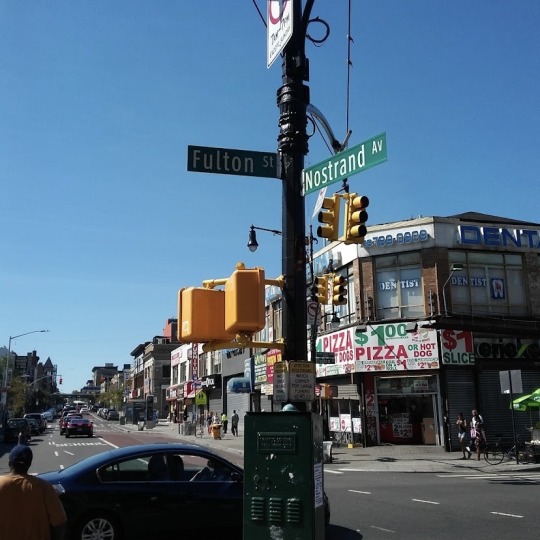
Although it can be hard to see, the other side to the left of it reads Nostrand Ave. Fulton and Nostrand is a very popular intersection in the neighborhood, mainly because there's a subway station for the A line located on one corner.
There's Nostrand and Fulton.
But if you turn to the other corner you see...A Bodega! Looks familar?

That's the bodega Spot robbed.
99% of the people who watch this movie will be from New York. Even less will be from BedStuy. Even less will catch the split second sign on the corner, only on screen for only a few frames.
It took me 3 watches to notice. But I noticed. And my jaw dropped. How much that means is unexplainable. I've been on that corner, and the TacoBell across the street. And so has Miles. That's insane.
It doesn't stop there.
Spot enters the store, as we pass we see a sticker for 'WIC/EBT' on the cashier's counter. I'm not sure how common this is - but WIC and EBT standards for Welfare Benefits and Food Stamps. As you cannot buy warm food with Food Stamps (sadly), lots of bodegas advertise taking EBT for the deli sandwiches.
Nice shout out to the struggling families in the communities, I love a Bodega that takes EBT.
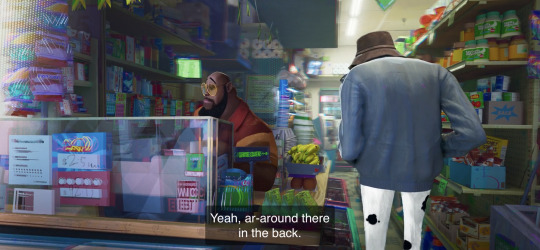
We move towards the back of the store - In the Bodega while Spot messes with the ATM we get a wider shot, and another very insanely specific shout out.

Behind Spot is a sign showing a Beef Patty (which I'll mention in a moment) and a sun logo called 'Sunny Patty'.


This is a direct call out to a specific chain of Beef Patty shops in Brooklyn and Harlem called 'Golden Krust'.
I cannot stress how much of a niche reference this is! Golden Krusts only exist in low income neighborhoods - mainly in Brooklyn, Harlem, and the Bronx. If you're anywhere near Times Square or any place else New York shows choose to portray - you're not finding a Golden Krust.
Golden Krusts are store that is ingrained in Caribbean culture, which Brooklyn is full of - hence the adapted Jamaican flag up front. I grew up eating Golden Krust and I'd eat it more if they didn't close so goddamn early.
But it's there.
Once again, only a few pixels, only a few frames, but someone probably took 6 hours drawing that. For the 0.009% of the people who'll get the reference. Low-income, black New Yorkers - like me.
ATSV is so accurate that you can even find the exact spot in which Miles and Gwen leave through the portal.
But before I tell you where it is - I wanna talk about why it's so important.
It's important because one of the most famous Spider-man scenes in history is just plain WRONG to New Yorkers.
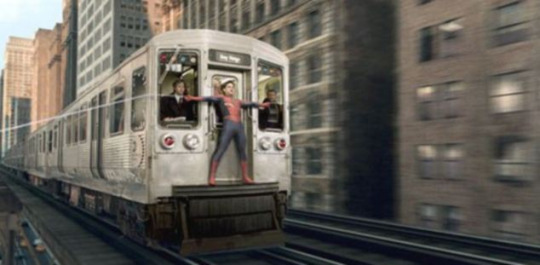
This scene is ENTIRELY incorrect, and I knew it even as a child.
Firstly, based on the skyscrapers everywhere, this is solidly Manhattan. The train says Bay Ridge, which is in South Brooklyn, maybe 40 minutes away by train. So I'm going to assume this is the Q or B train, running through Manhattan. Which, okay they do, but -
There are NO elevated trains in Manhattan. The Q, like every other train, only goes above ground in Brooklyn and Queens. This is very clearly Chicago.
So he couldn't be doing this. It's a simple but HUGE fuck up. Any one born in New York will notice it because Manhattan just looks wrong with elevated trains.
And it would've been fine if they just set it in Brooklyn where Bay Ridge and the elevated trains actually are.
But instead they made generic Manhattan streets - so much so I can't even tell what neighborhood they're in. Do you see how this is such a problem?
Across The Spiderverse is animated. And they still put in the effort.
I can't tell you where Peter Parker is stopping that train - it ain't Manhattan - but I CAN tell you where Miles and Gwen leave for Mumbattan.
So let's go back to where we started. We're on Fulton and Nostrand both in BedStuy.
Throughout the fight, we see Spot and Miles go through a couple streets - most notably a very popular street in the neighborhood - Broadway.
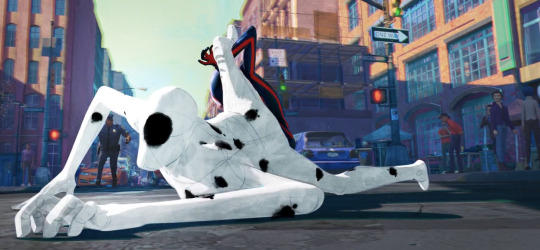
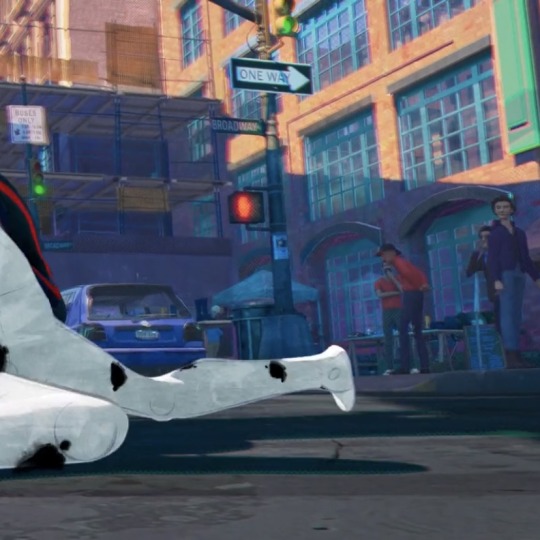
This happens twice, once while fighting Spot, and once when Miles and Gwen grab the hot dogs. They show this twice, cause this will be important for what we're trying to do.
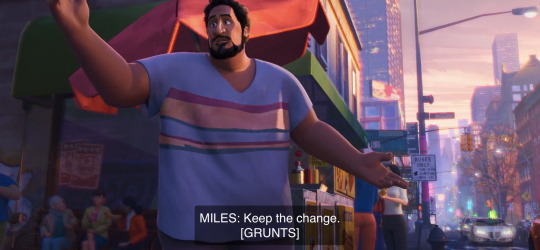

Now this may not make any sense to you, since it's just random streets, but I'm about to tie it together.

Gwen releases the bug near an elevated train. When we see Miles and Gwen swinging, they cling to a train. Now, it's hard to tell what train this is but so far we know.
We're in Brooklyn
We're near Broadway
We're near an elevated train line
There's a station on Broadway called Broadway Junction. It serves the G line and the J,M,Z line.
When we see the train pass by, we get a glimpse of the model. Each train line has a slightly different variation, with some being a lot old. The one that passes is one of the newer ones.
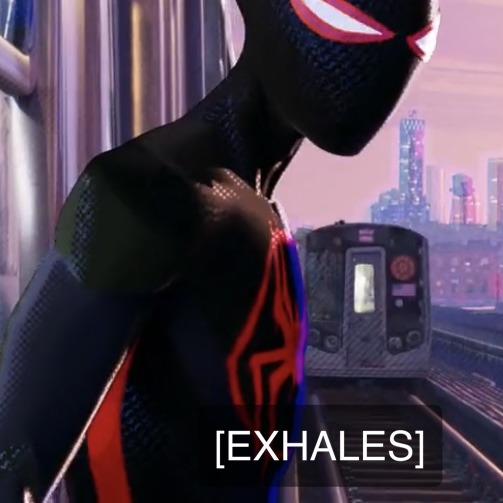

(Once again, very accurate, as those models do run on elevated lines)
And although we can't see the letter on the train, by that alone, I can guess we're by the elevated J,M,Z lines in BedStuy - near Broadway Junction. Easy. Now we just need to know what stop we're at.
Well, they tell us that too. Finally, When Spot heads into the building we get a glimpse of the exact street he's on - Bedford.Ave

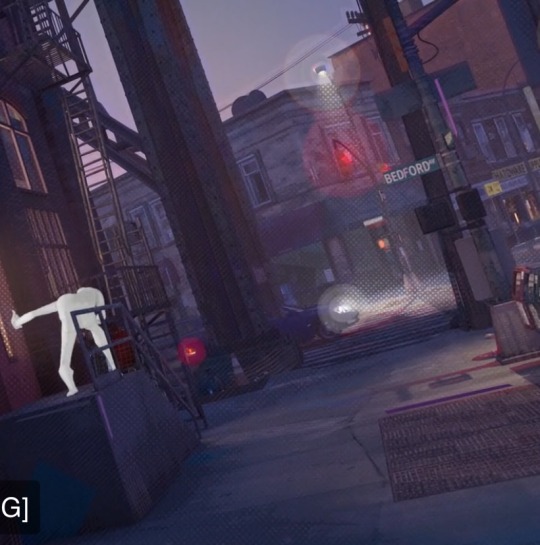
So I just threw a LOT of information at you - but look at this map of the J,M,Z line and hopefully it comes together

At the bottom along the green line - we see Bedford/Nostrand Ave.
Remember, the robbery starts us off on Nostrand.
Let's move up the green line. We get to a part where the green line passes the brown and orange ones - the JMZ trains.
They connect at Broadway (Officially Broadway Junction Station). We see Broadway with the hot dog vendor there.
If we move to left of Broadway we see Marcy Av. - and if we look to the left OF THAT we see a faint white line heading north.
THAT line is Bedford Ave. Where Spot enters the building.
Because we know they're in Brooklyn, and we know they passed Broadway. Plus we know they're now on Bedford by an elevated train that runs newer models.
So from those signs alone we can definitely say that Spot is on Bedford Ave. and Broadway. Next to the JMZ elevated trains, two stops from Broadway Junction in Brooklyn.
100% that's the spot (lol). That's the only place Bedford crosses an elevated train. And as a New Yorker, I got that from this photo.

Trust me when I say - we can tell.
By those short shots of street signs, we know that Miles started in BedStuy, swung north towards Broadway, then took a turn towards Bedford Ave in Williamsburg. And that's where Gwen plants the bug - and the place she returns to before going to Mumbattan.
Is that crazy? That's CRAZY. Percision accuracy that I have never seen in a movie live-action or otherwise.
All throughout the first scenes of ATSV - they are on actual streets, that are reasonably within swinging distance of each other, along actual train lines - with their stations accurately located.
That's INSANE. There was no need for that amount of detail, but they did it anyway.
There's SO many times in Spider-men movies where they'll start swinging in Queens, and then the next scene is like Upper Manhattan. They don't label the neighborhoods, but from buildings alone, I can tell what neighborhood it is.
And I'm supposed to believe Peter just swung 2 and a half boroughs in twenty minutes. I don't notice. But I NOTICE.
Here, Miles and Gwen are truly swinging accurate distances in the right amount of time. That's mental. And refreshing!
In a live action movie - they have NO excuse. Just film in the city, it's not like we're Gotham. And we give film crews huge tax breaks.
In an animated movie - completely understandable. But they still said 'No, that's subpar.' and went the extra mile.
They didn't even have to show ANY street signs, they could've left it at the easter egg at the corner store.
But they didn't. Because they're telling a story about a Black kid from Brooklyn, who leaves for someplace completely unfamiliar. BedStuy is Miles' home, and they wanted to make it feel that way. So when he's not there - in the cold polish of Neuva York - you can feel it.
You can feel Miles leaving his warm, rich community when he lacks that community in the Society. In the movie and IRL, BedStuy is so full of color, with so many people doing so many things and sharing so many cultures.
And in the society, everyone is the same. There's no culture. That's dedication.
Because of a train in Spider-man 2, I was immediately taken out of the story.
And because of train in ATSV, I was immediately brought in.
For once, it feels like they're swinging around a neighborhood - cause they are.
A Large Detail in ATSV:

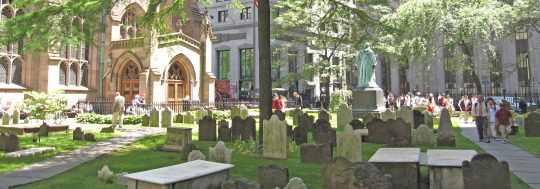
So I talked about Trinity Church - the real church that Peter Parker was buried at in ITSV - and how accurate the team got it to the actual building.
In fact, this is the spot where Miles is standing.
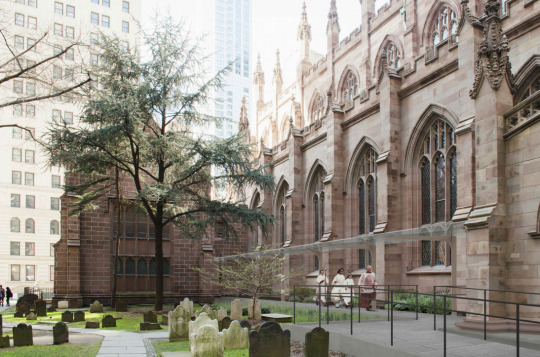
Like he's standing maybe 20 feet AT most from this spot, you can see in the windows and spires at the top.
But I also wanna explain why this - and why the fact that Peter was buried there is SO important.
Trinty Church is one of the most famous historical churches in the United States. It was started by the first English settlers in New York. It's extremely famous, and extremely sentimental.
For reference - Alexander Hamilton and his family are also buried at Trinity Church, along with dozens of other important US historical figures - across centuries.
You can't just be buried in Trinity. It's a city landmark. The cemetery is full, small, and you CANNOT pay your way in. The church is extremely choosy with who they will bury there - and honestly, I don't think anyone has been buried there for maybe a century or more.
So for the city to bury Peter Parker's body in the most prominent church in all of the city, if not the country - that speaks VOLUMES.
Like I said in the last post, my father use to work at Trinity Church - and they're the whole deal. Candles burning everywhere, super quiet and devote. The church has catacombs under it, everything.

They didn't just bury him anywhere. The people of New York went out of their way to give Peter Parker the most honorable burial physically possible within the city of New York.
The highest honor for any New Yorker. One reserved only for Spider-man.
Which I think was an amazing touch. Especially since Trinity is in downtown Manhattan - so anyone could come visit and pay respects.
Other Cultural Accuracies
Before we wrap up I wanna breeze through some other cultural accuracies that appear in ATSV.

Miles stops to eat a Jamaican Beef Patty while in the Bodgea. I spoke about these earlier with the Golden Krust sign. Jamaican beef patties are these flaky pastries colored with tumeric, full of spicy meat. And they are very popular with the large Carribean community in Brooklyn - which I'm apart of :)
In the case, we see the Beef Patties labeled with red dots. But Miles seems to go for the only one without it.
I'm guessing the red dots indicate which ones are the spicy Beef Patties and which ones are the mild, and Miles grabbed the last mild one they had.
They draw it really well, especially while Miles is eating it.
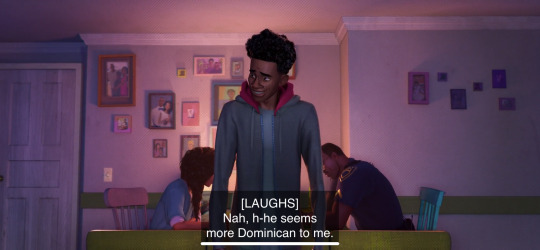
"Spider-man seems more Dominican." Genuine question - did anyone laugh at this joke in your theatre?
Because all three times I went, people laughed. The first time people LOVED that joke.
NYC, especially the Bronx has a HUGE Puerto Rican AND Dominican population - many times living side by side
And there's this kinda 'beef' in the same way Yankees fans have beef with the Mets fans (NYC baseball teams)
The best way I can describe the joke is that they're two very strong, very proud Spanish cultures that are often mistaken for each other - but Puerto Ricans and Dominicans can very obviously tell each other apart. Mainly because of the Spanish they speak.
So for him and his mom to have that back and forth, it's kinda an inside joke of Puerto Ricans and Dominicans getting confused for each other - but them being able to tell the difference.
His mom says Spider-man is Puerto Rican, but Miles corrects her - without backing it up with any reason.
It's like they can just TELL.
I don't know how else to explain the joke but its a very New Yorker thing to do - discuss that out like that.
Since a lot of us are the children of immigrants - it's knee-jerk to identify with your parent country and not this one.
If you ask someone in New York 'What are you'. Many young people (me included) would say "Oh I'm *parents nationality*." In my case, I say I'm Bajan and Peruvian. Even though I was born in New York.
Miles would say he's Puerto Rican though he's never been.
So them discussing where Spider-man is 'from' even though he's obviously a New Yorker is the joke.
Like - someone on the writing team HAD to be from New York to add that in cause it's so...oddly New Yorker???

While swinging Miles and Gwen pass the B46 bus. Once again, completely accurate. The scene starts on Nostrand and Fulton. The B46 does indeed stop on Fulton St.

When they're swinging, the movie accurately shows the new World Trade Center (aka The Freedom Tower) - which is the tallest building in the picture.
Also, the bridge to the LEFT is the Brooklyn Bridge, while the tall one on the right is Manhattan Bridge. Many people don't know there's actually two bridges. (There's more but those two are the main ones)
Good on them for showing both Bridges, both accurately placed as well
Fun fact: Trains run over the Manhattan Bridge - the Q, B and a couple others (beautiful - I love it when they do) but trains do not run over the Brooklyn Bridge.

And lastly, when Miles and Spot are on Broadway, the school behind them is actually architecturally accurate for a Brooklyn school. So much so that design is iconic.
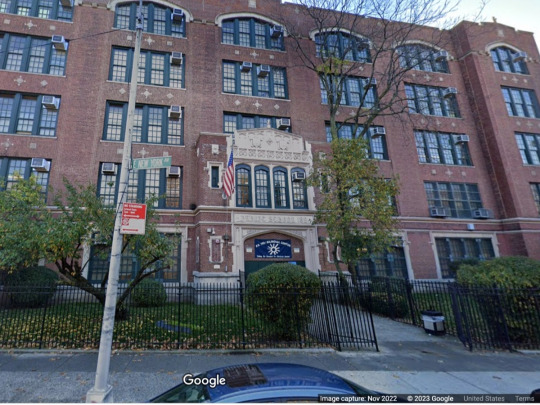
______________________
So those are most if not all of the cultural accuracies in Across the Spiderverse!
I cannot stress enough how ridiculously bang on this movie is in terms of everything.
The team put in so much work, and it paid off. To me, at least.
I don't feel like Miles is some kid from a different alternative New York. I feel like he's a real kid in MY New York. From everything down to his Jordans (don't even get me started on how much Jordan's has a CHOKEHOLD on teenagers in New York. Like...it's a status thing. Even since I was a kid, everyone wanted Jordans. Jordans or Nike Air Force 1s. So having Miles wear Jordans is my favorite thing cause yea a kid from BedStuy would think those are flyest shit ever even though they're just regular degular Jordans lol. And you KNOW Miles 42 a sneakerhead. Look at those shoes. He aint creasing those)
This movie, is chef's kiss. It tops all other New York portrays - live-action or otherwise and I stand on that.
If you read this far, thank you SO much. I love sharing New York culture (and the cultures that make it what it is to begin with) and I'm SO happy I can share this stuff and hopefully help people appreciate the movie more too!
If you learned something or have any questions, I'm all ears!
And I usually leave a photo of Hobie here as a send-off but this post hit the photo limit LMAOOOOOO
Bye.
#no proofread as usu#atsv#across the spiderverse#miles morales#gwen stacy#the spot#spiderman#spider man#spidergwen#spider gwen#atsv analysis#marvel#across the spider verse
249 notes
·
View notes
Text
just a very quick explanation about eastern european melancholy because it seems important to me -- this term as well as the general concept of melancholy can often be found in art and literature analysis and basically describes how the general depiction of eastern europe is... less than favourable. for example, eastern european characters like in bram stoker's dracula are characterised as being distincly different and not as culturally advanced compared to "modern" western cultures, a trend that is sometimes still seen today when looking at cultural stereotypes.
in the context of the movie damon and kris watched as well as historically, this term now more often refers to a general feeling of hopelessness that is caused by unstable political as well as economic conditions due to the situation post wwii and then the dissolution of the soviet union as well as yugoslavia.
the fact that damon and kris both felt that it was important to illustrate this cultural aspect not just through art but by choosing to evoke a female figure, a slavic babushka, means a lot to me, personally. i was joking with @izpira-se-zlato that damon made kris look like my grandma -- but, as with a lot of people here i assume, my grandma was born in post-war eastern europe and was a young girl during the same time period this movie takes place in and was also forced to experience and live through a lot of hardships in early communist poland.
i do believe that kris feels a strong connection to his slavic heritage and culture (he was the one rambling about interslavic, after all) and the fact that damon felt something, too, while watching the movie and that they wanted to express it together is something that feels very, very important to me and i honestly love and appreciate them so much for doing that.
#joker out#i enjoyed the memes but i was also having a breakdown because this is so very important to me#sometimes i realise i have a degree that is indeed also focused on culture and not just literature can you believe#i guess the meaning is also very very apparent for a lot of slavic people here because well#we all live(d) through it#there's a reason why my parents emigrated#anyway#kris guštin#damon baker
138 notes
·
View notes
Text
Emphasizing Louis's Beauty
I've talked previously about how Louis in the 2nd half of the season is rarely seen in suits anymore but what about the earlier episodes when he wears a wide array of colorful suits while he is still performing his role in human society? What stands out is how many vibrant colors and patterns we see him in vs. Lestat who is always in some kind of tan, gray or navy. A lot of this is simply historical record as vibrant colors were more typical of black male dress of the era and we see that Louis is trying to maintain appearances, but on the show his bright costuming always stands out from other background male characters black OR white (confirmed by the costume designer that his colors are like a flame drawing Lestat in) and the tailoring and color choices often stands in contrast to Lestat on screen next to him in a more traditional masculine (aka duller) color. I mean compare this to how romantic period dramas typically style the men and women.


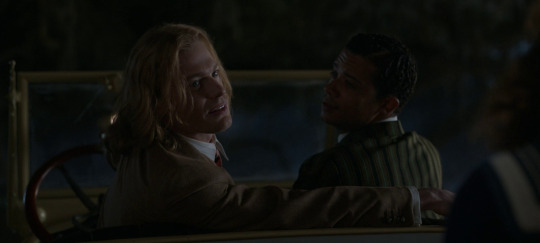

Beyond the historical nods, which most tv viewers don't have detailed references to as there aren't many color images we have from that era, I think the show does a great job of connecting cultural references everyone can immediately pick up on (the Leydecker outfits were obvious examples). For example, if you think of a white stripey suit from the 1910s, the image that came to mind was probably Rose in Titanic. So even as Louis is projecting what was period standard masculinity, what the modern viewer is likely thinking of is a tailored suit worn by the female protagonist in one of the biggest movies of all time. These looks screams high fashion latest designs from Paris, decked out pampered princess of the ship ("prince of your district").
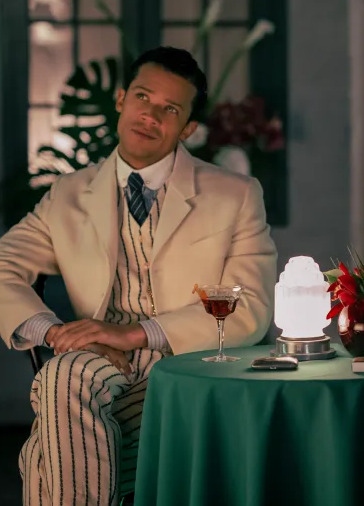

In the same vein, when you imagine an iconic green period costume you're probably thinking of Keira Knightley in Atonement. In fact if you google "green suit in period film" all the results are of women. Rarely are men put in these colors in period romances particularly. I mean I think they put Keira in that green dress simply because she looks incredibly beautiful in that color and that's also how I feel about Louis in his green outfit.

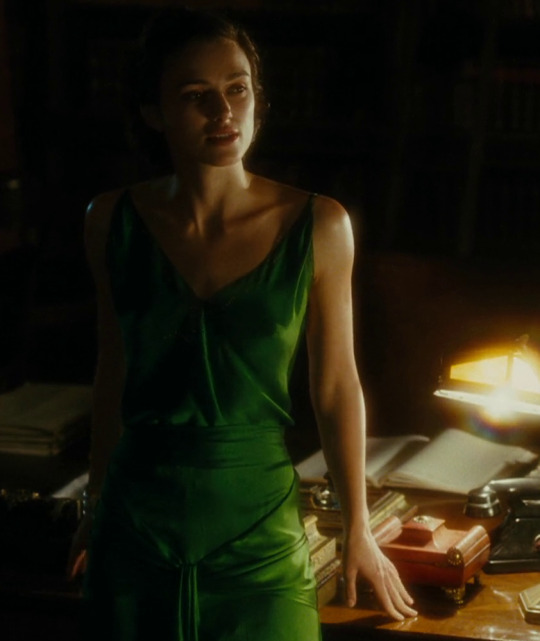
I've talked before about the use of red on Louis but looking at the actual context of when Louis wears red they are specifically scenes of lust (w/ Jonah), shame (the slutshamig w/ the soliders) or anger/revenge (killing the Alderman) and hello look at these!!




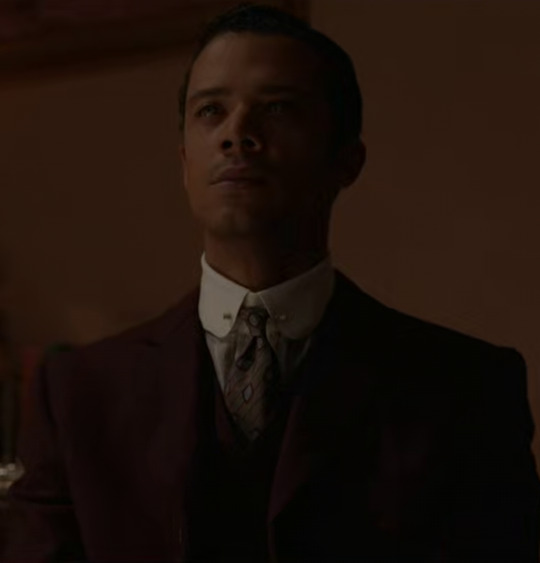
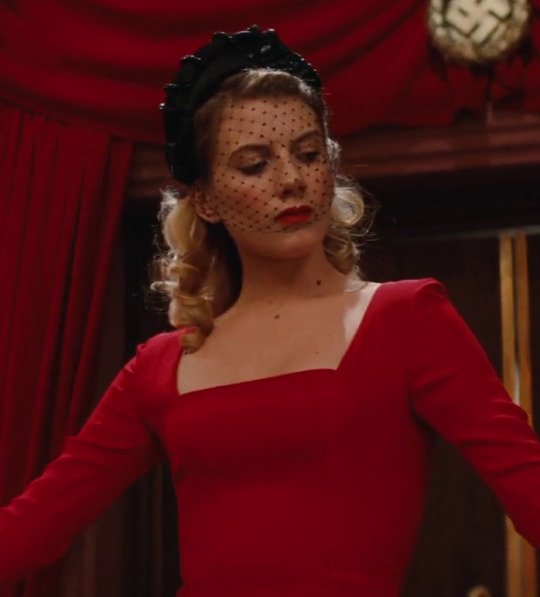
And this is really an exclusively female character trope where vivid color costuming is used to convey mood or emotion! When a man is angry or lustful in a film, he's never wearing red, he's just wearing a boring color like black or grey. Evil and goodness are conveyed by black vs. white costuming with men (i.e Lestat's evil black darth vader get up) but rarely any colors not on that b&w scale.
Also speaking of cultural references in costuming here's this again.
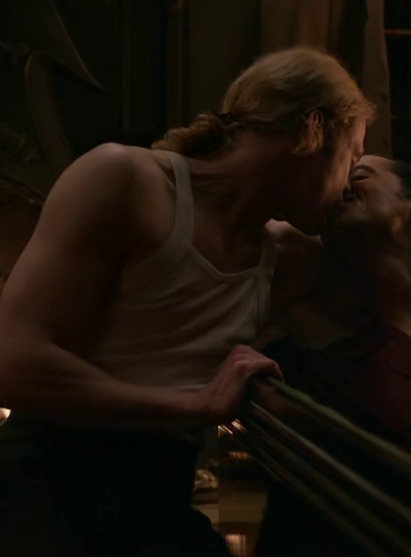
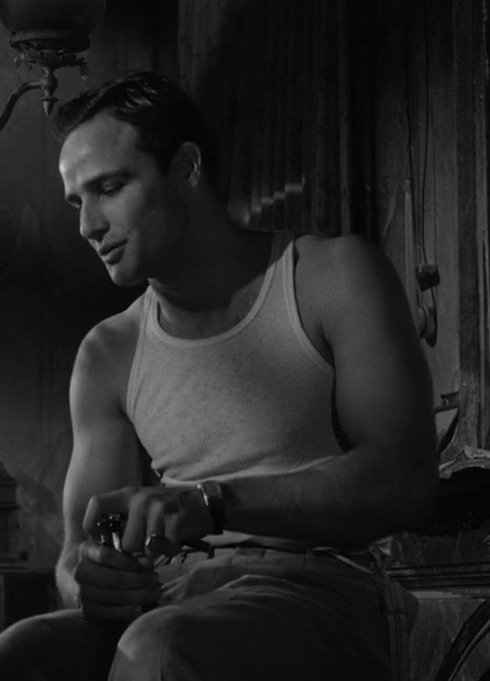
#iwtv#im making everyone look at the wifebeater outfits with their eyes taped open like its clockwork orange#my point is the costumes make louis even prettier while they make lestat appear powerful#(and scary)#so many outfits highlight how broad his chest is and his giant ass biceps#costume analysis
397 notes
·
View notes
Note
Yo, I saw your post about orientalism in relation to the "hollywood middle-east" tiktok!
How can a rando and university dropout get into and learn more about? Any literature or other content to recommend?
Hi!! Wow, you have no idea how you just pressed a button. I'll unleash 5+ years on you. And I'll even add for you open-sourced works that you can access as much as I can!
1. Videos
I often find this is the best medium nowadays to learn anything! I'll share with you some of the best that deal with the topic in different frames
• This is a video of Edward Said talking about his book, Orientalism. Said is the Palestinian- American critic who first introduced the term Orientalism, and is the father of postcolonial studies as a critical literary theory. In this book, you’ll find an in-depth analysis of the concept and a deconstruction of western stereotypes. It’s very simple and he explains everything in a very easy manner.
• How Islam Saved Western Civilization. A more than brilliant lecture by Professor Roy Casagranda. This, in my opinion, is one of the best lectures that gives credit to this great civilization, and takes you on a journey to understand where did it all start from.
• What’s better than a well-researched, general overview Crash Course about Islam by John Green? This is not necessarily on orientalism but for people to know more about the fundamental basis of Islam and its pillars. I love the whole playlist that they have done about the religion, so definitely refer to it if you're looking to understand more about the historical background! Also, I can’t possibly mention this Crash Course series without mentioning ... ↓
• The Medieval Islamicate World. Arguably my favourite CC video of all times. Hank Green gives you a great thorough depiction of the Islamic civilization when it rose. He also discusses the scientific and literary advancements that happened in that age, which most people have no clue about! And honestly, just his excitement while explaining the astrolabe. These two truly enlightened so many people with the videos they've made. Thanks, @sizzlingsandwichperfection-blog
2. Documentaries
• This is an AMAZING documentary called Reel Bad Arabs: How Hollywood Villifies A People by the genius American media critic Jack Shaheen. He literally analysed more than 1000 movies and handpicked some to showcase the terribly false stereotypes in western depiction of Arab/Muslim cultures. It's the best way to go into the subject, because you'll find him analysing works you're familiar with like Aladdin and all sorts.
• Spain’s Islamic Legacy. I cannot let this opportunity go to waste since one of my main scopes is studying feminist Andalusian history. There are literal gems to be known about this period of time, when religious coexistence is documented to have actually existed. This documentary offers a needed break from eurocentric perspectives, a great bird-view of the Islamic civilization in Europe and its remaining legacy (that western history tries so hard to erase).
• When the Moors Ruled in Europe. This is one of the richest documentaries that covers most of the veiled history of Al-Andalus (Muslim Spain). Bettany Hughes discusses some of the prominent rulers, the brilliance of architecture in the Arab Muslim world, their originality and contributions to poetry and music, their innovative inventions and scientific development, and lastly, La Reconquista; the eventual fall and erasure of this grand civilization by western rulers.
3. Books
• Rethinking Orientalism by Reina Lewis. Lewis brilliantly breaks the prevailing stereotype of the “Harem”, yk, this stupid thought westerns projected about arab women being shut inside one room, not allowed to go anywhere from it, enslaved and without liberty, just left there for the sexual desires of the male figures, subjugated and silenced. It's a great read because it also takes the account of five different women living in the middle east.
• Nocturnal Poetics by Ferial Ghazoul. A great comparative text to understand the influence and outreach of The Thousand and One Nights. She applies a modern critical methodology to explore this classic literary masterpiece.
• The Question of Palestine by Edward Said. Since it's absolutely relevant, this is a great book if you're looking to understand more about the Palestinian situation and a great way to actually see the perspective of Palestinians themselves, not what we think they think.
• Arab-American Women's Writing and Performance by S.S. Sabry. One of my favourite feminist dealings with the idea of the orient and how western depictions demeaned arab women by objectifying them and degrading them to objects of sexual desire, like Scheherazade's characterization: how she was made into a sensual seducer, but not the literate, brilliantly smart woman of wisdom she was in the eastern retellings. The book also discusses the idea of identity and people who live on the hyphen (between two cultures), which is a very crucial aspect to understand arabs who are born/living in western countries.
• The Story of the Moors in Spain by Stanley Lane-Poole. This is a great book if you're trying to understand the influence of Islamic culture on Europe. It debunks this idea that Muslims are senseless, barbaric people who needed "civilizing" and instead showcases their brilliant civilization that was much advanced than any of Europe in the time Europe was labelled by the Dark Ages. (btw, did you know that arabic was the language of knowledge at that time? Because anyone who was looking to study advanced sciences, maths, philosophy, astronomy etc, had to know arabic because arabic-speaking countries were the center of knowledge and scientific advancements. Insane, right!)
• Convivencia and Medieval Spain. This is a collection of essays that delve further into the idea of “Convivencia”, which is what we call for religious coexistence. There's one essay in particular that's great called Were Women Part of Convivencia? which debunks all false western stereotypical images of women being less in Islamic belief. It also highlights how arab women have always been extremely cultured and literate. (They practiced medicine, studied their desired subjects, were writers of poetry and prose when women in Europe couldn't even keep their surnames when they married.)
4. Novels / Epistolaries
• Granada by Radwa Ashour. This is one of my favourite novels of all time, because Ashour brilliantly showcases Andalusian history and documents the injustices and massacres that happened to Muslims then. It covers the cultural erasure of Granada, and is also a story of human connection and beautiful family dynamics that utterly touches your soul.
• Dreams of Trespass by Fatema Mernissi. This is wonderful short read written in autobiographical form. It deconstructs the idea of the Harem in a postcolonial feminist lens of the French colonization of Morocco.
• Scheherazade Goes West by Mernissi. Mernissi brilliantly showcases the sexualisation of female figures by western depictions. It's very telling, really, and a very important reference to understand how the west often depicts middle-eastern women by boxing them into either the erotic, sensual beings or the oppressed, black-veiled beings. It helps you understand the actual real image of arab women out there (who are not just muslims btw; christian, jew, atheist, etc women do exist, and they do count).
• Letters of Lady Mary Wortley Montagu. This is a feminist travel epistolary of a British woman which covers the misconceptions that western people, (specifically male travelers) had recorded and transmitted about the religion, traditions and treatment of women in Constantinople, Turkey. It is also a very insightful sapphic text that explores her own engagement with women there, which debunks the idea that there are no queer people in the middle east.
---------------------
With all of these, you'll get an insight about the real arab / islamic world. Not the one of fanaticism and barbarity that is often mediated, but the actual one that is based on the fundamental essences of peace, love, and acceptance.
#orientalism#literature#arab#middle east#islam#feminism#book recommendations#reference#documentary#western stereotypes#eurocentrism#queer#queer studies#gender studies#women studies#cultural studies#history#christianity#judaism#books#regulusrules asks#regulusrules recs#If you need more recs#or can’t access certain references#feel free to message me and I’ll help you out!
62 notes
·
View notes
Text
Of fandom, age, and David Tennant being our own personal Time Lord
I read the fantastic post that @davidtennantgenderenvy wrote about David Tennant and aging (if you haven’t yet read it, go for it!) and, as a fan who is closer to DT's age range than to what seems to be the rest of the fan base's age (yeah, being well over 40 is A THING), I had an interesting mix of ideas and emotions. I was going to just reblog her post with some of these musings, but when this started getting longer (and I started searching for bibliography, ha), I decided that I was not going to hijack her post, but rather cite it (and reblog it on its own right, really, read it). I should say that this is a long essay, and it comes peppered with references to one of my preferred fields of study (but I make it light and fun, promise).
Becoming an “old geek”
The first time I came into the idea was when I found a thirst TikTok with that very nice audio that goes “I think I need someone older…” and clearly, the thirst was there, but also… David is 8 years older than me, and when you are 45, thirsting over someone who is 53 doesn’t feel as “edgy” (and thinking about “needing someone older” starts verging on thirsting over people well over 65, which is absolutely fine, but a very different category over all for the rest of TikTok). So yeah, it was weird. You see someone who you feel is "in your range" and everyone is calling them "old"… And you start thinking about aging, inevitably.
Of course, I "don't feel old", but most of my friends are younger than me, and I'm the oldest person in many of my "fun activities". Take, for example, my lightsaber combat team, where every sponsorship is pitched to people under 30, and you should be training at least twice a week and following a strict diet to reach the expected “competitive or exhibition” level (enter the “old lady” who is taking this training just for fun, who needs to take care of her joints and who is not going to be invested in becoming Jedi Master General or anything of the sorts in the near future). Or we can talk about the expectation about fandom in general being a “teenage phase”, and thinking about everyone who still is into it actively after certain age as “immature” or “quirky” at best (hi, mom! Hi, work colleagues! Hi, students!).
Society, aging and social constructs
Of course, this has a lot to do with societal expectations. For almost 80 years, popular culture has been built around "youth" and "young people": before rock & roll, most things (music, clothes, movies, art in general) were targeted to “adults”, and you were expected to be “a functional adult” since a younger age. There was a seismic shift in the way popular culture was built when consumer culture decided to see and cater young people: trends became shorter, being “hip” was desirable, staying younger for a longer period was a nice aspiration (a good, light reading to get a deeper view around this is “Hit Makers” by Derek Thompson. It is written for marketers, but that makes it an easy historic overview and I like that). This has a lot to do with the change of our view about old people, too: while being old 100 years ago (yup, 1924 still fits the bill) made you “a respected elder” and you were expected to be wise, to know best, to be the voice of reason and an expert, nowadays not even us older people like being seen as “old” or “older”.
Frequently, culture becomes entrenched in binary oppositions. The binary opposition between “young” and “old” is… well, old! And while the opposition is sustained, the meanings around it change over time (that’s what the past paragraph was about, really). If in the 1940’s being old meant “mature, respectable, wise, responsible” and being young meant “inexperienced, immature, foolish”, after the 1950’s those meanings shifted a lot: being young became “fun, interesting, in the now and in the know, attractive”, while being old was about being “boring, dusty, passé, uninteresting, dull”.
In reality, being young can be a mix of all of these things (inexperienced and fun and foolish and attractive), and being old can be, at the same time, being responsible and wise and a little dusty and dull, because that’s life *shrugs*, and the wonder of lived experience is that, even if we simplify it, it is complex and rich and sometimes contradictory in itself: we can be old and foolish and interesting and boring, or young and dull and inexperienced and attractive. But, as we need to make “social sense” of things, simplifying them is… easier. That’s why we build stereotypes, and why we use them! We need to have a “base” of signifiers to build upon, so we usually take what we have on our environment and run with it. If you find this idea interesting, welcome to the world of cultural semiotics! *takes her Iuri Lotman picture out of her pocket and puts it on the desk*

(Iuri Lotman, people. He is my "patron saint").
Pop culture versus “real culture”
Another cultural opposition that piques my interest in this area is the notion of “pop culture”, of course. It is opposed to “real, serious culture”, the sort of thing that everyone expects "older, mature people" to enjoy. In the sixties and seventies, there were a lot of studies and writing about "high brow" and "low brow" culture, trying to keep this distinction between "things that make you familiar with the now, but have no intrinsic value" and "eternal things that cultivate your mind, soul and spirit".
Evidently, if you ask me, this is a whole load of horse manure: probably useful to fertilize other things, but with little intrinsic value on its own. My main point is not dolphins, but the idea of culture: historically, it has used to mean a lot of things; from the notion of (exactly) fertilizing something and making it grow to make it come to fruition, to the hodgepodge of practices that a social group creates when they are together and are trying to make common sense of things.
I like the latter better (that is the one I’d ascribe to if this was The Academia TM, but this is tumblr!), but another popular definition, which comes from the Illustration and has been quite prevalent, is the notion of culture as the set of cultural practices that make you a better, more intelligent, far more educated person. For example: if you want to have real culture, you have to read Shakespeare and know what a iambic pentameter is, rather than watching “10 Things I Hate About You”. You must read real books, not listen to audiobooks, and “real books” should be written by “serious authors” like (insert old white Western European or American cis men, preferably born before 1960).
Here comes the notion of “cultural canon”, grinning widely. Yup, that set of practices becomes an expectation of what and how you should experience any area of the human experience, and they become a sort of “nucleus” of the whole experience, with people playing “defense” around them and culture shifting all around and sometimes across them. This is not exclusive to “high culture”: Have you ever heard about “gatekeeping”? Yeah, same fenomenomenon (Shadwell, of course). Whenever something gets this “shape”, it becomes a “norm”, the “common” thing, the “rule” if you participate in that set of cultural practices.
As every cultural set of practices tends to generate its own “canon”, they also have a lot of practices surrounding it, which are ever changing, shifting, learning from new and old practices, and redefining what everything means in their common/shared space. For example: Neil Gaiman, my beloved, was part of the “comics” frontier when Sandman first appeared, but as he and Alan Moore (yeah, I know he did it first, but Gaiman is my study focus right now, so let me be) and other very talented and interesting people started creating fascinating stuff that hadn’t been done, and they found people who loved it, they not only redefined the world of comics, but became part of the new canon themselves. And then, Neil’s presence in the world of literature and fantasy became widespread and recognized and then revered… And then he is doing it again by adapting his own work to a streaming platform in a serialized way… I hope this explains why I’m growing an obsession with studying Neil Gaiman as an author who crosses through different media: a transmedial auteur, an anomaly in his own right. But that is not an essay for tumblr, but a thesis, one that I don’t know if I’d ever have the time or mental resources to write (being a runaway ex academic with ADHD who works on their own is hard, people). Besides, this was about aging and David Tennant, so let’s cut this tangent short and start talking about our Time Lord and Savior: David Tennant, the king of frontiers.
David Tennant as a Frontier Lord
David Tennant is another fascinating case in this sense, mostly because he is an actor who has been able to build a whole very impressive career through crossing symbolic frontiers. Through his massive filmography (161 roles just for screens, as registered in IMDb) and his stage career (I love this gifset for this exact reason), he has acted his way through almost everything, from classical Shakespeare to improvisational comedy, from procedural police drama to wacky fantasy sci-fi. This has a lot to do with his personality (he loves acting, he decided to pursue acting as a career thanks to his love for Doctor Who, but he is also smart and inquisitive) but, as it happens with a lot of “frontier figures”, it also has a lot to do with “unpredictable” circumstances: less of a strategy, more of an instinct.
David has talked many times about how his impostor syndrome made him feel, for the longest time, that he had to keep accepting roles, because you never know if there is going to be another one after. He is talented and open and curious (this is quite a good interview about his perspective), but this… anxiety? meant that he had also lower quandaries about saying “yes” to roles and projects that were “less consistent” with a typecast (which has been, for the longest time, one of the main strategies to build an acting career). Yeah, he has some defining characteristics that make a role “tennantish” (I’m not starting that tirade here, but yeah, you know that almost fixed set of quirks and bits), but he has also worked his way through many different genres, budgets, styles and complexities. And he has usually been as committed and as professional in a big budget-high stakes-great script sort of situation, as he has been in a highly chaotic-let’s see what sticks-small scale project.
That can be correlated by the way he talks about “acting advice”. “Be on time, learn your lines, treat everyone the same, never skip the lunch queue”… Acting is a job, and he treats it as such. Yeah, he looks for interesting projects anytime he can, but the “down to earth” attitude about it is, once again, not-usual, not-common: pure frontier. Then, when David talks about his own self (specially at a young age), he is pretty clear about his “outsider” or “uncool” status (this interview is fantastic), and how strangely disruptive it was to become not only recognizable, but cool and sexy and… everything else, thanks to Doctor Who. He went from living in the frontier to being put in the canon, but he is still, at heart, a person who is more comfortable not defining himself by that “expected” set of rules.
Him being a very private person, who insists on having a family life that seems, form this distance, stable, loving and absolutely un-showbiz just makes the deal (and the parasocial love and respect) easier to sustain; as does his openness to talk about social and political issues that interest him (passionately, again; against the norm for “well liked celebrity”, again). His colleagues also talk wonders about him, mostly because he is this sort of down-to-earth but also passionate about his craft and easy to work with. Again: not the “norm”, not the “rule” of being such a celebrity.
Many of his fans (should I say that I’m one? Or is it obvious at this point?) find this not only endearing, but comforting: he is a massive star, who has acted in a lot of terrific roles in huge productions… But he feels, at heart, as “one of us”. But he is, also, a well-respected thespian, a Shakespearian powerhouse, an international talent. He lives in a very authentic, but very unstereotipical frontier. And he seems happy about that and has made a career from it. Extensive kudos and all the parasocial love and the amateur-actress mad respect for that.
I should mention, just in passing, that a “natural” archetype for this characters that traverse frontiers… are tricksters. Think again about the “tennantish” characteristics. Here goes another essay I’m not writing right now.
Aging: The Next Frontier
This takes me to the original post that inspired the essay: living in a culture where the “norm” is “being young and famous is a desirable aspiration”, we have a fantastic actor, at peak of his craft, who is in the heart of middle age (past 50, nearing 55). Not only that, but he is an actor with whom at least a couple of generations have grown older: from the ones who feel him as “our contemporary” to the ones who grew up looking at him (like Ncuti Gatwa!).
David, being the frontier person he is, has been navigating this transition in a very “unconventional” way: he came back to the role that made him iconic (The Doctor, now with more trauma!), is starring in another fantasy series about middle-aged looking ethereal beings that at times is an adventure thriller, at times is a comedy of errors and at times is a romcom (having another beautiful trickster of a man as his co-star… There goes another tangent that is an essay); he is playing one of the quintessential Shakespeare roles for middle-aged men (Macbeth), and is, seemingly, having a lot of fun doing a lot of voice acting for animation roles (if you haven’t watched Duck Tales, you’re missing a whole lot of fun, really).
Traditionally, middle aged actors navigate that period of their career trying to reinforce their “still young, thus a celebrity” status (for example, doing a lot of action-packed movies and keep doing their own stunts while seducing women 20-30 years younger than them), or strengthening their “prestige thespian, so now a real culture person” position (fighting for more serious roles, going from comedy to drama, or working their way into The Classics©). Sometimes, they face the internalized societal expectation by also becoming a shipwreck in their personal life (yeah… the stereotype of “getting divorced, having an affair with someone half their age, getting another red convertible, getting in trouble…”) because we don’t have a good “map for aging responsibly” yet as a society. We have been so focused on youth, that we have forgotten how to age.
Again, switching to the personal experience. I was raised as a female-shaped person (yeah, being queer is fun), so part of the experience of growing (and then growing old) has been closely related with that concept from the female point of view. I decided, pretty early on (but not so much, probably 25 years ago), that I wasn’t going to conform to the norm… And that included aging naturally. When I found my first white hair, it was a shock (I was 21 or 22), but I had already seen my father fighting his own hair being white since forever. I decided it was a loss of time, money and effort… And the judgement from people in my generation and in the one that preceded me (my mother, my aunts) was stern and strict: “it will age you, and it will date us. You shouldn’t do that”. Men could do it, given the right age (being over 50) but women must not. Same with wrinkles and sagging and gaining weight and getting “pudgy”. But when men grew older, they needed to make a “show off” of their ability to seduce, to “still be a man”. Aging, then, was undesirable by any standard.
As me and my peers have grown older, and my hair has gotten increasingly silver, there have been women that come to me saying that “I look great” and “they wish they were as brave as me”. I would like to state in front of this jury of my peers (hi, tumblr!) that the only bravery it took was deciding, somewhere between my twenties and my thirties, that I wanted to be as myself as I possibly could, so no bravery at all, just the same lack of understanding of social rules that took me to become interested in… you guessed it, cultural semiotics. We’ve come full circle with this. Now, let’s finish talking about what it means for an aging fan to have an aging star to look up to, shall we?
David Tennant as a cultural Time Lord
I am pretty sure that he wouldn’t have chosen this role for himself (as he wouldn’t have chosen being a massive star just by playing his favorite character and being so talented and charming), but he is, as Loki would say, burdened by glorious purpose. Being “the actor of his generation”, and him crossing so many frontiers with such ease and grace, without even thinking about it too hard, just because he is a hard worker and likes to try new things and is just so good at what he does put him in the exact cultural crossroad for it.
He is not in a sudden need to “resignify himself” as anything: he has already shown his very flexible acting muscles through his very long career. He is not bounded to “keep his public image relevant”: he likes to have his personal life clearly separated from the spotlight, and being married to the brilliant and funny Georgia, who herself grew up with a famous father, so she is no stranger to staying sane and in control in the eye of media, and who manages their social media presence with a good mix of humor and well-set boundaries.
Therefore, he is in a moment where he can (and probably will) chose to do whatever he likes. And he has the public support to do so: he is prestigious and respected, but likes to make fun of himself and is not self-important; he has a lot of awards, but he is also a very likable person with whom most people in the industry enjoy working. And he is up to do a lot of things: heroes, villains, morally grey characters; romance, drama, thriller, fantasy, sci-fi, procedurals, historical fiction, classic plays, silly parts, voice acting… We are going to see him aging on screen and stage, with no playbook: the playbooks were written for people that certainly are not him. And I have some evidence to prove it.
He is starring in a groundbreaking series (yeah, Good Omens) where the protagonists are two middle-aged looking entities, full of queer relationships, written by another trickster. This series, in an on itself, is a showcase for characters that are rule breaking in many ways: in the narrative, by being hereditary enemies who are inevitably linked to one another by a loving bond that may or may not be romantic, but that has been in the making for 6,000 years; in representation, by having the protagonists being represented by a couple of middle aged actors who are “not serious” and “not action” coded, in a role where they are delivering romance, banter, intrigue, joy and a whole other range of emotions that are “not your stereotypical” middle-aged male-lead coded.
He also delivered the baton on a relay race with Doctor Who: he came back after almost 20 years, to bring back the generation who grew up watching him in the role, and deliver us into the arms of Ncuti Gatwa’s 15th Doctor, with the promise of taking a rest and working on getting better from all the trauma The Doctor has endured in 20 years Earth-time (which, as any Doctor Who fan knows, account for centuries of trauma in Doctor’s time). Not your usual Doctor Who Anniversary cameo, but one built to deliver some zeitgeisty emotional health promises that made the specials feel… healing. At least, for some of us.
Even when it wasn’t the hit series it deserved to be, his Phileas Fogg in “Around the World in 80 Days” is also a great delivery of an unconventional middle-aged protagonist, who goes from meek and scared and too worried about societal norms, to a lovely, tender, slightly awkward and daring person, with friends half his age who look at him but are also his peers (another kind of relationship that is not very frequent in media).
And, with all fearlessness, he has played a lively old duck in Duck Tales! Scrooge McDuck has never been a middle-aged character: he is, quite openly, an old gentleman. An adventurer, quirky, with a lot of spunk… but also quite clearly an elder to Huey, Dewey and Louie, and obviously older than Donald Duck (who is also not a young adult himself!). When you watch that series, and if you have the opportunity to catch any glimpse of him behind the scenes while recording the part, you can feel the joy he got from playing the part (and he has said time and again that he IS Scrooge McDuck, so it will become his “recurring bit” for the future).
Hopefully, David (and some other actors and actresses, for sure) will dare to build that new “aging publicly without making an arse of myself” playbook, and I (and I can imagine, many other fans in our middle age, but also fans that are right now leaving behind the “young adult” stage and becoming “adults” fair and square, and others who will arrive to this place at a future time in their lives, so I hope) will be there to bear witness, support, cheer… and learn from the model. Because that’s what fandom is about, but also because that’s how culture itself gets shaped and changes, continuously. And that is exciting and a little scary, and that’s why it is better if we do this together.
And I'd love to imagine diverse (in the full sense of the word) role models for this process and this playbook, too!!!
If you read all the way through this, I'm very grateful, take a cookie, have a gold star and suggest names for our aging interestingly role models on the "non-white-male" side of things!
Class dismissed!!
#david tennant#aging#aging gracefully (or not)#long essay#long post#cultural studies#cultural semiotics#I need someone to pay me for writing this sort of stuff really#when I said I was writing again I meant it#this was 6 pages long in Word#and it includes references#look at my (written) child#the doctorate in cultural studies would never#neil gaiman
105 notes
·
View notes
Note
bestie what did you call those fucking parrots??? "bloodthirsty parakeet satirical caricatures of the Mussolini facist regime" like... what?? genuinely confused, could you explain it to me?
Yeah! Tbh I read this post that made the connection, and thought “damn that made sense actually.” They explain it really well:
(Og post for ask context)
To add on:
The parakeets carrying Himi to the great grand uncle were passing through the world of their ancestors and were tearing up about it. It relates to the above post about fascists glorifying the mythic past
The parakeets held up signs with “Duch” when rallying around their king. This might be a reference to the Italian word “Duce” (meaning “duke” or “leader”). Mussolini is known as Il Duce (“The Leader”), and the term is virtually inextricably associated with him
Parakeets symbolize a variety of things, but in this case may symbolize mindless herd mentality
The culture of the parakeets is very militaristic—even the way they walk is a march—as well as nationalistic. It parallels the show of Japanese nationalism at the start of the movie
When Mahito wakes up in the parakeet kitchen, the chef is gleefully preparing to cook him. It’s almost as if he expected Mahito to celebrate the fact too, but regardless the parakeet doesn’t care about the massacre of others because the victims will serve their regime. Someone I know has a more personal reading of this scene, and they connect it to how, historically, oppressors would celebrate their atrocities as some great deed while the oppressed watched and suffered. The parakeets only cared about their own “greater cause”
Ive seen people also say that the parakeets are stand-ins for the Japanese fascists, German fascists, or human fascists in general—but whatever the specifics may be, the parakeets do seem to represent fascism.
Maybe when the parakeets escaped the underworld and turned into normal birds, it’s their wish being fulfilled: they’ve become their ancestors they glorified so much. They returned to the “great mythic past,” but as it turns out, the “great mythic past” is a great big lie, and probably different from the glory they imagined.
Alternatively, they coveted the peace and simplicity of their ancestors, but they were trying to achieve that through violent and militaristic means, and felt justified in doing so
Alternatively, the parakeets like the pelicans were trapped into this fantasy world, and forced to play roles to parallel the wars of humanity. When they finally escaped, both they and Mahito are free to live as themselves in the real world.
Maybe I’m wrong about some details or missed something, but yeah, that’s where “bloodthirsty parakeet satirical et cetera” came from
#the boy and the heron#how do you live#parakeet#parakeet king#spoilers#hayao miyazaki#studio ghibli#ask box#analysis
74 notes
·
View notes
Text
Nimona headcanons part 3 bc I'm insane (out of order and disorganized so like- be ready) and bc it's my new year gift for y'all
• Nimona mostly talks like a normal teen but sometimes she'd use words that show her real age. "Sonorous", "vapidity" n stuff like that. Her vocabulary is INSANELY huge
• Ambrosius tries not to swear so he uses a lot of silly replacements instead. "HOLY S- golly!!", "You son of a b- bishop". Like I'm sorry but he's the type of guy to say fricking instead of, yknow, the intended word. Ballister finds it endearing; Nimona finds it stupid
• Yes yes he does replace sex with lovemaking. Yes he purely refers to him and Bal going at it as "making love". Yes he's a fellow like that
• Ballister doesn't drink alcohol. I know that's implied in the movie that he drinks (although I thought he drank, like, soda?? On the other hand he is a wholeass thirty years old man who's seen some shit so I wouldn't be surprised) but idk he strikes me as a type to refuse drinking out of moral code. He doesn't eat pork for the same reasons (pushing my cultural Muslim Ballister agenda)
• Ambrosius drinks only during celebrations or parties. Not much because he's a light drinker😭 one cup and he's already lying on the floor, crying and hyperanalyzing his life
• after Nimona came back Ambrosius was not safe from her jokes. Neither of them despised each other (not after Nimona saved the whole Kingdom and not after Ambrosius proved he really isn't a jerk) but boy does Nimona make fun of him on any given occasion. Ambrosius was taken aback by this at first but then he just got used to it
• Ambrosius is being kinda petty and jealous when Ballister spends more time with Nimona than him ("Although now apparently he's got a new best friend, what's that about?!"), not in a way that'd make it unhealthy ofc but still😭. Him and Ballister were tied to the hip for like the most of their lives and now there's someone ELSE Ballister likes to hang out with? Ugh🙄
• Ambrosius had a diary when he was a teen, he didn't write much there (one or two sentences a day). Once he became an adult he kind of forgot about it but after the whole... Hunting stuff started happening he found himself writing a ton of sentences there again
• when him and Bal started dating Ambrosius had a whole page in that diary filled with "Ambrosius Boldheart" HE'S A GUY LIKE THAT OKAY
• Ambrosius likes to attack Ballister's face with quick little kisses. If he pecked his forehead he must peck his cheeks and nose and eyelids and cheekbones etc etc
• Nimona sometimes speaks in rhymes. She doesn't know how she's doing it but her tongue just does it on its own. ("Let's go dunk on the punk in the trunk")
• Ballister has actually been a year older than everyone in his class, another reason why he was the black sheep™
• Ambrosius can play the flute and the piano due to his noble upbringing he HATES whenever someone brings it up tho
• Nimona and Ballister have those nights where they recall historical facts and situations and Nimona shows her perspective of the things. "The guy claimed to be a war criminal was the biggest sweetheart in the world what are you onnn". Ballister wrecks his brain trying to understand if she's serious or not
• Ballister doesn't get a lot of the jokes, they just fly over his head. Only after some time he starts getting them, like in the middle of the night randomly going "ohhhh that's what she meant"
• first time Ambrosius and Ballister made out Ambrosius threw his hands in the air and said "yayy :D"
• Ballister's haircare routine is better than you think it is he's just casual about it. Yes he uses coconut oil like his life depends on it
• Ambrosius's complexion is leaner but Bal's is broader. So when they exchange clothes it doesn't fit because Bal's shirts are too loose on Ambrosius but also kinda short and Ambrosius's are kinda long but too tight in the shoulders for Bal. They still think it's sweet to swap their clothes sometimes
#this one is kinda short#but still#nimona#ambrosius goldenloin#ballister boldheart#goldenheart#nimona headcanons
71 notes
·
View notes
Text

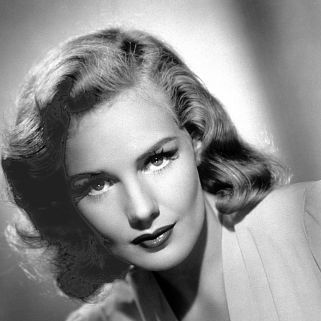
Propaganda
María Félix (Doña Barbara, La Mujer sin Alma, Rio Escondido, La Cucaracha)—Maria Felix is still possibly the most well-known Mexican film actress. She turned down multiple-roles in Hollywood and a contract with Metro-Goldwyn-Meyer in order to take roles in Mexico, France, and Argentine throughout the 1940s, 50s, 60s. She was so famous and so respected as a dramatic actress that she inspired painters, novelists and poets in their own art--she was painted by Diego Rivera, Jose Orozco, Bridget Tichenor. The novelist Carlos Fuentes used her as inspiration for his protagonist in Zona Sagrada. She inspired an entire collection by Hermes. In the late 1960s Cartier made her a custom collection of reptile themed jewels. She considered herself to be powerful challenger of morality and femininity in Mexico & worldwide--she routinely played powerful women in roles with challenging moral choices and free sexuality. But even still, years after he death, she is celebrated with Google Doodles, and appearances in the movie Coco, and holidays for the anniversary of her death.
Frances Farmer (Among the Living)— has multiple songs written about her, a mentally ill icon, sexy as fuck and a feminist icon
This is round 1 of the tournament. All other polls in this bracket can be found here. Please reblog with further support of your beloved hot sexy vintage woman.
[additional propaganda submitted under the cut]
María Félix:

She's Thee Hot Vintage Movie Woman of México. She's absolutely gorgeous and always looks like she's about to step on you. you WILL be thankful if she does.
"María Félix is a woman -- such a woman -- with the audacity to defy the ideas machos have constructed of what a woman should be. She's free like the wind, she disperses the clouds, or illuminates them with the lightning flash of her gaze." - Octavio Paz
María Félix is one of the most iconic actresses of the Golden Era of Mexican Cinema. La Doña, as she was lovingly nicknamed, only had one son, and when her first marriage ended in divorce her ex-husband stole her only child, so she vowed that one day she’d be more influential than her ex and she’d get her son back. AND SHE DID! María Félix rejected a Hollywood acting role to start her acting career in Mexico on her own terms with El Peñón de las Ánimas (The Rock of Souls) starring alongside actor, and future third husband, Jorge Negrete. She quickly rose to incredible heights both in Mexico and abroad, later on rejecting a Hollywood starring role (Duel in the Sun) as she was already committed to the movie Enamorada at the planned filming time. Of this snubbing she said, quote: “I will never regret saying no to Hollywood, because my career in Europe was focused in [high] quality cinema. [My] india* roles are made in my country, and [my] queen roles are abroad.” (Translator notes: here the “india” role means interpreting a lower-class Mexican woman, usually thought of indigenous/native/mixed descent —which she had interpreted and reinvented throughout her acting career in Mexico— and what abroad was typically considered the Mexican woman stereotype, with the braids, long simple skirts, and sandals. This also references the expectation of her possibly helping Hollywood in perpetuating this stereotype for American audiences that lack the cultural and historical contexts of this type of role which would undermine her own efforts against this type of Mexican stereotypes while working in Europe) She was considered one of the most beautiful women in the world of her time by international magazines like Life, París Match, and Esquire, and was a muse to a vast number of songwriters (including her second husband Agustin Lara,), artists, designers, and writers. Muralist Diego Rivera described her as “a monstrously perfect being. She’s an exemplary being that drives all other human beings to put as much effort as possible to be like her”. Playwriter Jean Cocteau, who worked with her in the Spanish film La Corona Negra (The Black Crown) said the following about her, “María, that woman is so beautiful it hurts”. Haute Couture houses like Dior, Givenchy, Yves Saint Laurent, Balenciaga, Hérmes, among others, designed and dressed her throughout her life. She died on her birthday, April 8, 2002, at 88 years old, in Mexico City. She was celebrated by a parade from her home to the Fine Arts Palace in the the city’s Historic Downtown, where a multitude of people paid tribute to her. Her filmography includes 47 movies from 1942 until 1970, and only two television acting roles in 1970. She has 2 music albums, one recorded with her second husband, Agustín Lara, in 1964 titled La Voz de María y la inspiración de Agustín «The voice of María and the inspiration of Augustín», and her solo album Enamorada «In Love» in 1998. Her bespoke Cartier jewelry is exhibited alongside Elizabeth Taylor’s, Grace Kelly’s and Gloria Swanson’s. In 2018, Film Director Martin Scorsese presented a restored and remastered version of her film Enamorada in the Cannes Classics section of the Cannes Festival and Google dedicated a doodle for her 104th birthday. On august 2023 Barbie added her doll to the Tribute Collection.

123 notes
·
View notes